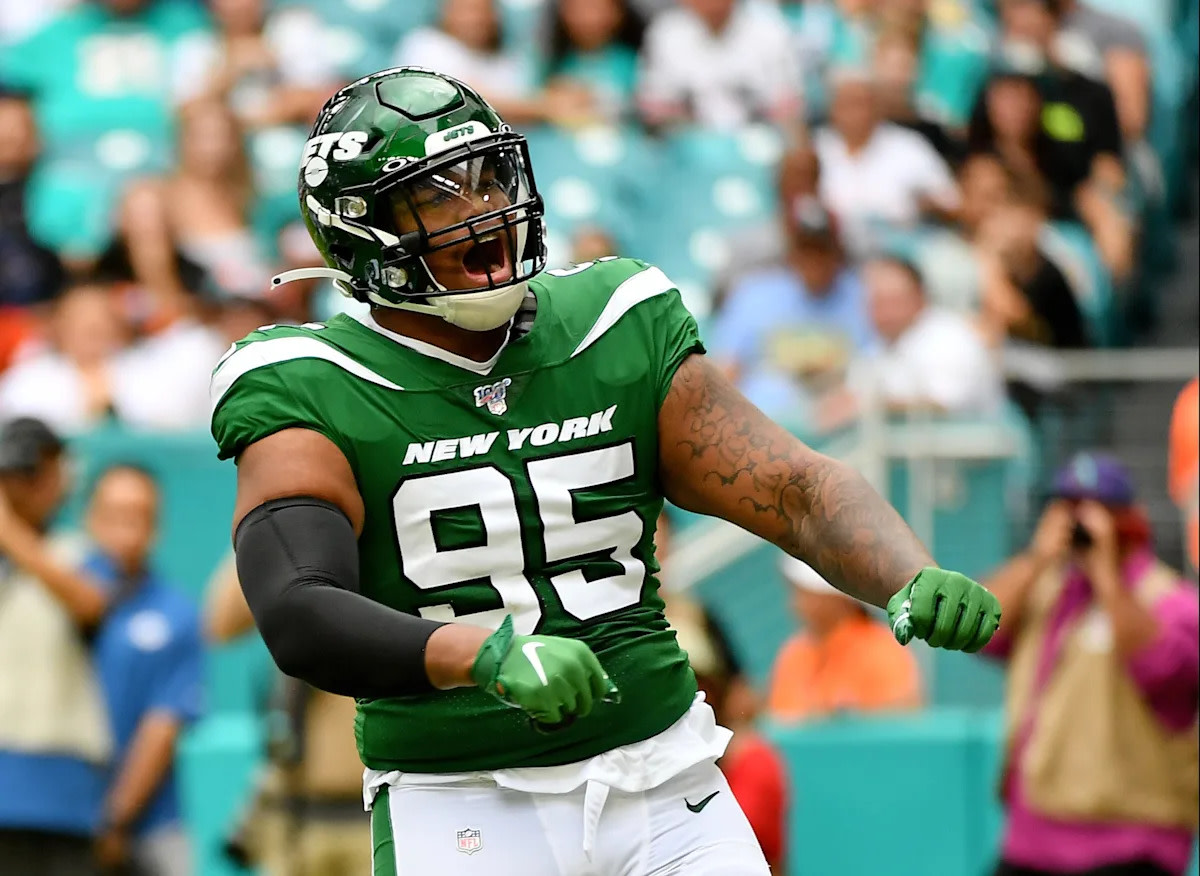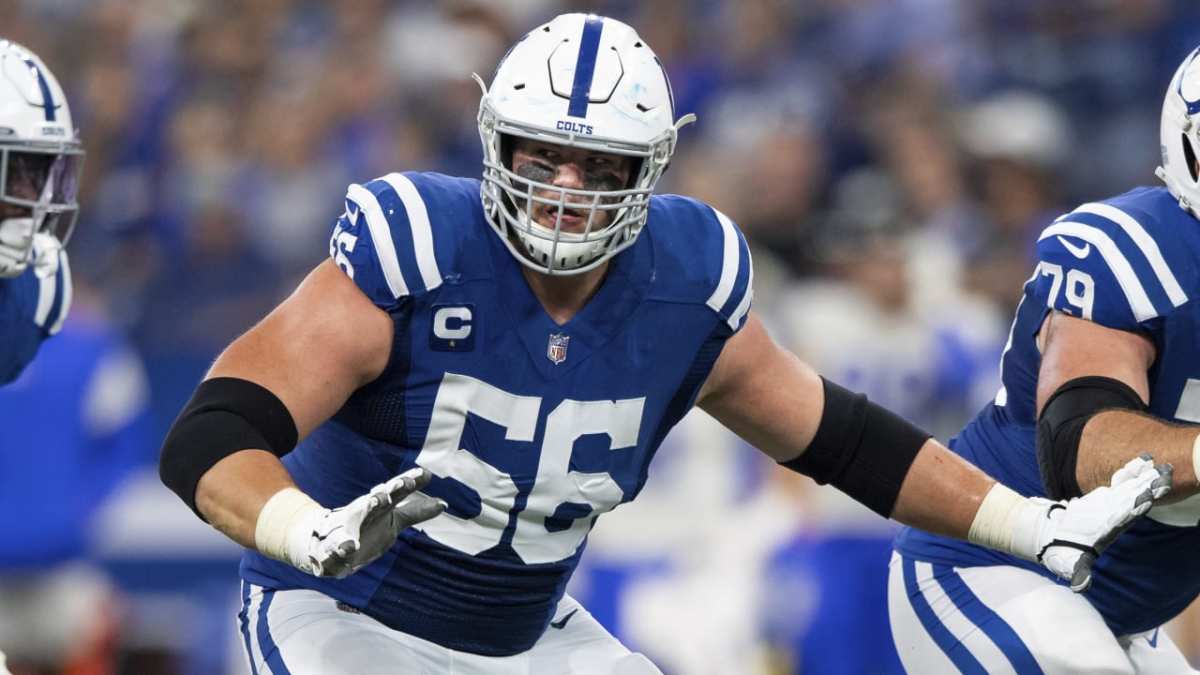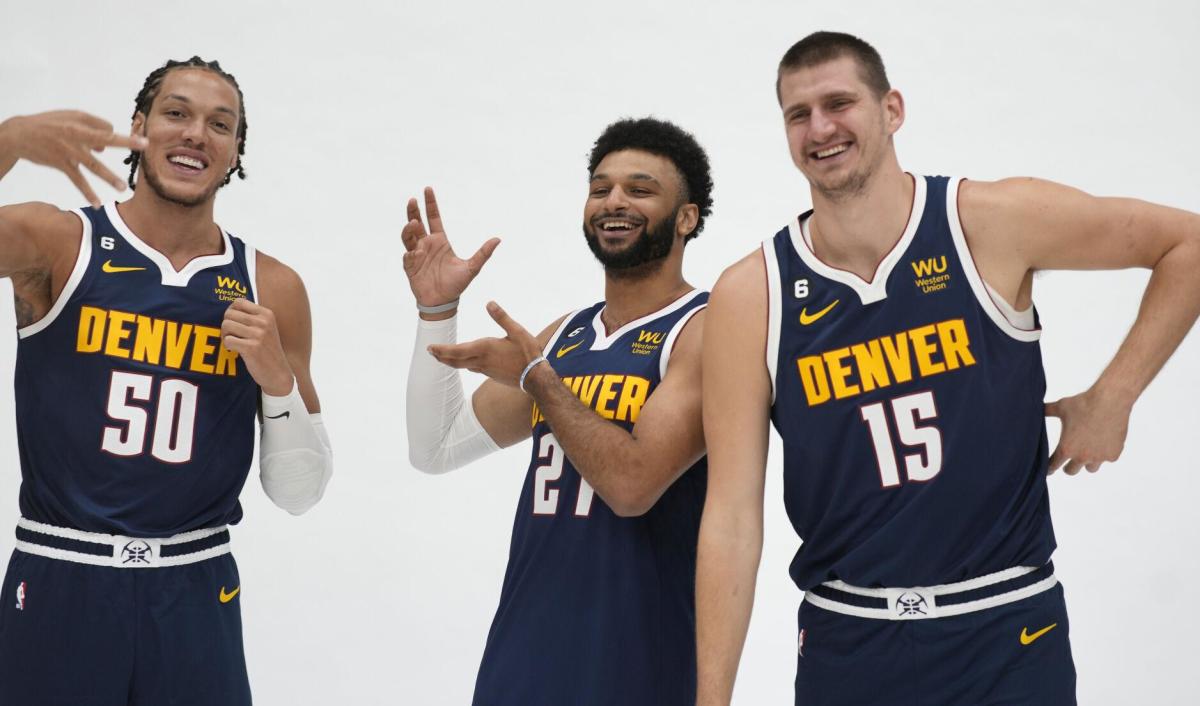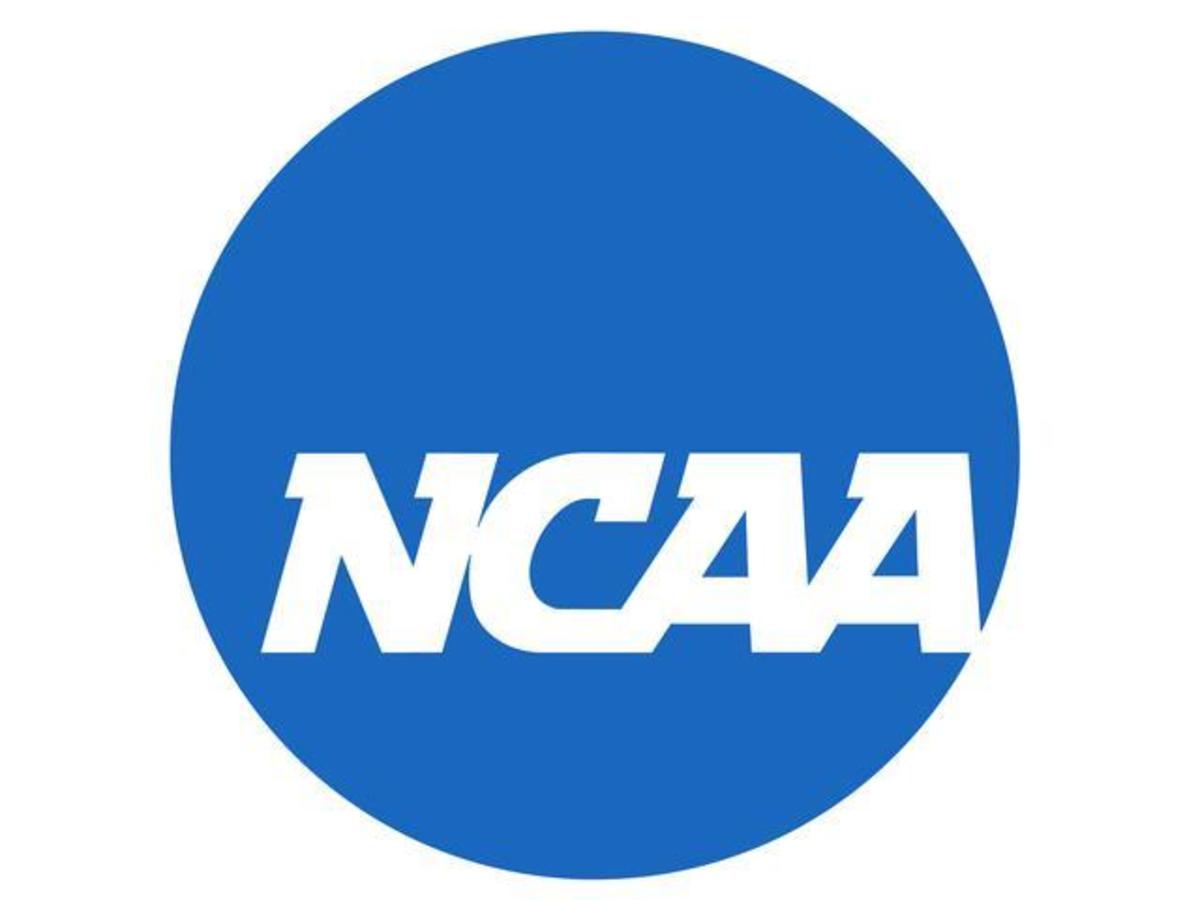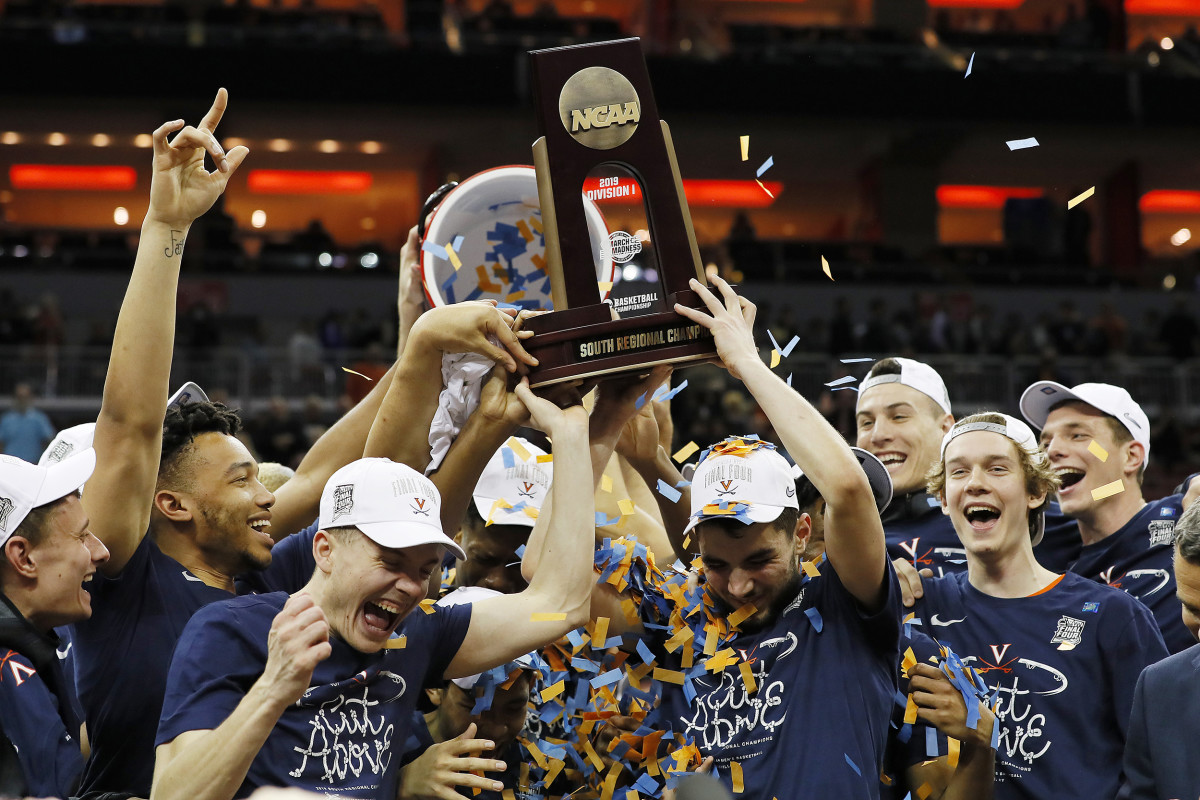- HubPages»
- Sports and Recreation»
- Team Sports»
- Basketball
2015-2016 ACC Basketball Preview (Updated)
After an underwhelming pre-conference performance, the ACC dominated last year's NCAA Tournament. The aftermath has left Duke, Louisville, Notre Dame, and North Carolina St. as very different teams- but for the conference as a whole, change can be good. Nearly one quarter of the top 100 high school recruits landed in the ACC, as did several of the most prominent graduate transfers available. Duke, Louisville, and Syracuse have rebuilt quickly, while Wake Forrest is beginning to recover from a dark page in that programs history (too dramatic?). Otherwise, major change is coming to all of college basketball, as the move to a thirty second shot clock could alter the game dramatically- although hopefully for just one season. Look for three point shooting to become more important than ever as the last offensive resort becomes the only option far more often. Otherwise, while overall scoring should increase due to the increased number of possessions, shooting percentages are likely to decrease while turnovers increase, meaning some games could be very difficult to watch. In a conference where most of the teams win games at the defensive end, that should mean more overall non conference success and, unfortunately, a large number of games that will be just plain ugly.
February 19 Update: Instead of getting bogged down defensively, most of the ACC responded to the shot clock rule change by becoming significantly more efficient offensively and focusing on their ability to shoot the 3. The result has been a completely different brand of ACC basketball. Louisville's questionable decision to make itself ineligible for the postseason (an act the NCAA will hopefully revisit this offseason and eliminate as a possibility in the future) unfortunately takes a major player off the board for the conference, and some late season conference attrition will likely result in only 6 or possibly 7 ACC teams participating in this year's NCAA Tournament.
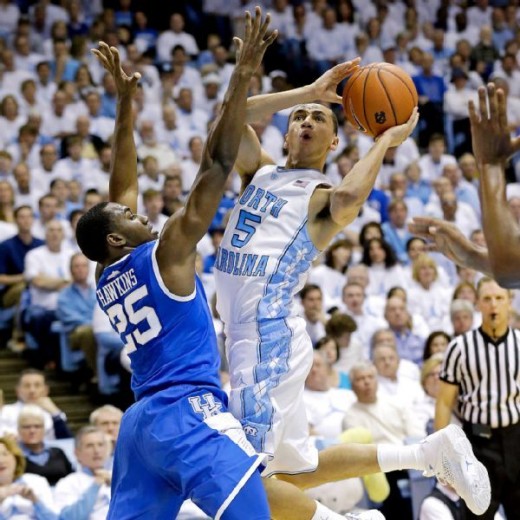
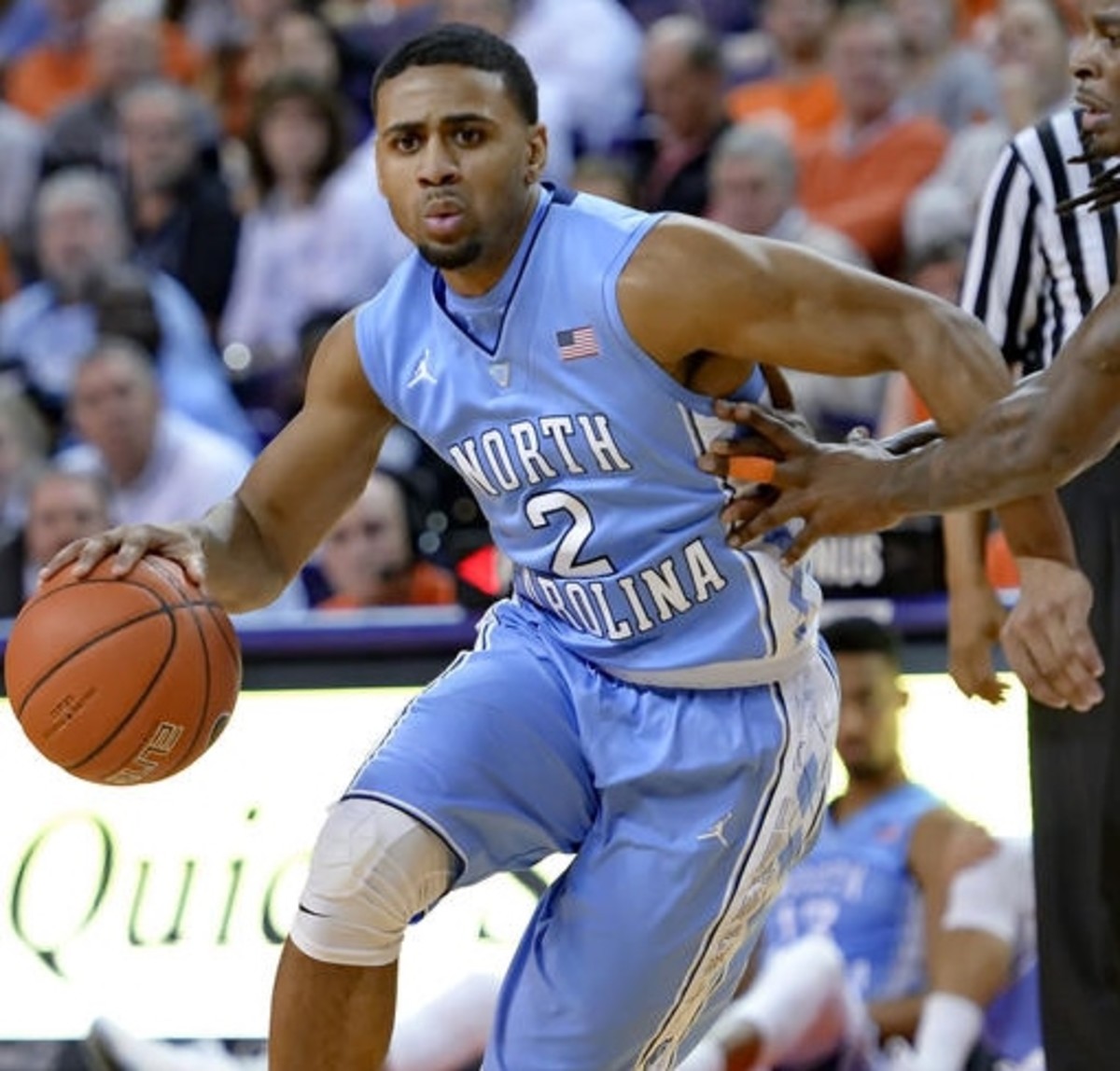
North Carolina Tar Heels
2014-2015: 26-12, 11-7 in the ACC; lost to Wisconsin in the NCAA Sweet 16
Preseason Projection: 1st in the ACC; National Champions
Final Standing: 1st in the ACC; National Runner Up
Departures: J.P. Tokoto (8.3 ppg., 5.6 rpg., 4.3 apg.) was selected in the 2nd round of the NBA Draft
UNC returns all but one of it's rotation players, including four players currently projected as first round picks in next years draft, from a team that finished 9th in rebounding margin, 18th in assist to turnover ratio, and 44th in field goal percentage defense a season ago, making the Tar Heels an early favorite to win a National Championship in 2016.
The loss of Tokoto will almost certainly hurt North Carolina defensively, but it should provide minutes for an additional shooter or ballhandler on the floor, allowing a team that was already efficient offensively to be even better. Williams has three solid point guards to mix and match in the backcourt when Justin Jackson is off the floor or slides to small forward. Even with so much talent now on the roster, senior Marcus Paige (14.1 ppg., 4.5 apg., 39.5% 3pt.) will again be the team's most important player. While it appears that his frame may never hold the weight necessary to be successful in the NBA, it hasn't stopped him from being one of the best college point guards in the country. He struggled with plantar fasciatis a season ago, so there is reason to believe he will be even better as a senior. Joel Berry didn't live up to his status as a top 20 recruit early as a freshman, but after returning from a groin injury he averaged 6.7 points per game on 50% 3 pt. shooting in March. Nate Britt did everything well except shoot as a freshman; although minutes were hard to come by, he was able to do that as well as a sophomore, shooting 36.4% from 3 for the season. Like Berry, Jackson struggled early, but averaged 13.4 points on 44.7% 3 pt. shooting over the team's last 12 games. He will start along with Paige, but at what position is yet to be seen. While he has great length at 6-8, he may not have the strength to rebound the position as well as Tokoto. On the other hand, 6-6 sophomore Theo Pinson definitely can. While he was injured for much of the season and received limited opportunities once he returned, he did at least prove that he can rebound, averaging more per minute than Tokoto a season ago. A top ten recruit last year, just how good Pinson will become will be one of biggest variables for this year's Tar Heels.
The combination of slender 6-9 senior pogo stick Bryce Johnson (12.9 ppg., 7.8 rpg.) and slimmed down yet still imposing 6-8, 255 pound junior Kennedy Meeks (11.4 ppg., 7.3 rpg.) was tremendously effective all season for North Carolina (with the exception of a poor showing against Kentucky's NBA front line), particularly on the boards, where both averaged over 7 rebounds per game. The next man up is Isaiah Hicks, who provided instant offense off the bench at times a season ago. He can get pushed around in the post, and hasn't been much of a rebounder to this point, so there are areas that he needs to improve upon as a junior. Williams also has the option to throw a gigantic, imposing senior center at opposing post scorers in 6-10, 280 pound Joel James, or to go to a stretch four and actually have four dangerous perimeter shooters on the floor by playing 6-8 freshman Luke Maye, a top 100 recruit nationally.
In addition to having one of the most experienced teams in the country, Roy Williams now has every option he could possibly want available to him. Extra ball handlers, extra shooters, extra size, more athleticism or length defensively- whatever he needs is available. As great as Tokoto was at times, he was the player most likely to provide an unforced turnover, so offensive efficiency may actually improve, and, with so many options offensively and what should still be an imposing defense, the shorter shot clock can only help the Tar Heels. That being said, the pressure is definitely on UNC; it's Final Four or bust, and the team is also dealing with an off the court academic scandal that isn't likely to make things any easier.
February 21 Update: Some weaknesses have been exposed during the last half of the Tar Heels' backloaded schedule. While the team has several very capable perimeter shooters, they often don't shoot well; they're currently 302nd in the country in three point shooting percentage. The starting backcourt also struggles to defend larger guards, and the team has been inconsistent at that end as well, currently ranking 88th in field goal percentage defense. On their best nights, the Tar Heels can beat anyone, but a national title suddenly seems to be asking a lot from this group.
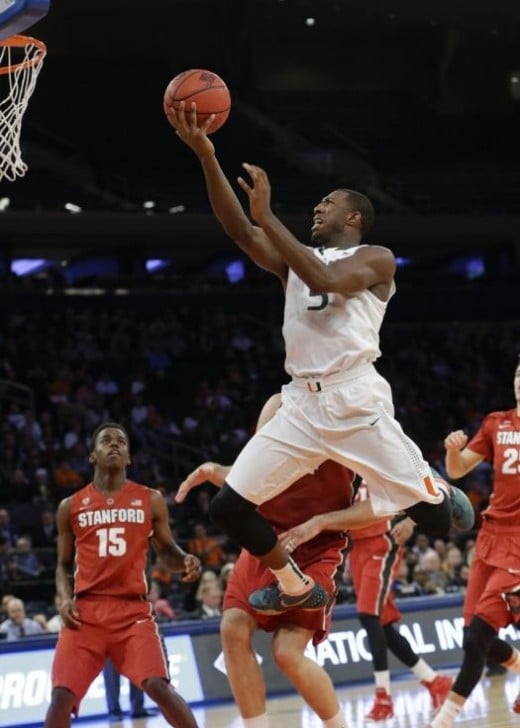
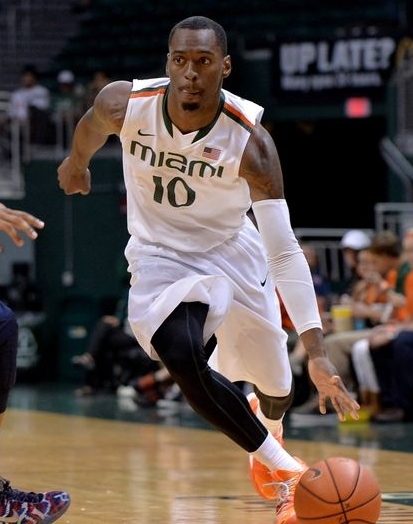
Miami Hurricanes
2014-2015: 25-13, 10-8 in the ACC; lost to Stanford in the NIT Title Game
Preseason Projection: 5th in the ACC; NCAA Round of 32
Final Standing: Tie for 2nd in the ACC; NCAA Sweet 16
Departures: Manu Lecomte (7.9 ppg., 45.6% 3pt.) transferred to Baylor; Deandre Burnett (7.0 ppg.) and Omar Sherman (4.8 ppg., 2.3 rpg.) also decided to transfer.
There were great expectations for Jim Larranaga's backcourt of transfers a year ago, but not everything worked out as planned. 6-5 senior Sheldon McClellan (14.5 ppg., 4.7 rpg., 35.8% 3pt.) more than lived up to expectations in his first season in the ACC, and he was a key reason for the team's postseason success in the NIT. Unfortunately, fellow transfer Angel Rodriguez struggled with inconsistency and missed most of the end of the season with a wrist injury. He's a clutch scorer and disruptive defender when things are going well, but he can try to force things when they're not and he's injury prone. If he struggles as a senior, JaQuan Newton, a top 60 recruit last year, should be better prepared to step in; he'll receive more consistent playing time following the transfers. At small forward, 6-6 junior Davon Reed could be the team's breakout star; he averaged 10.3 points 4.7 rebounds and hit 47.9% of his 3's over his last 22 games after recovering from an offseason knee injury, and was another big reason for the team's NIT run. Sophomore James Palmer should see increased minutes as well; while his opportunities were limited, he played in every game and displayed promising athleticism along with the ability to handle the basketball and hit the 3. With 6-7 freshman Anthony Lawrence Jr., a top 100 recruit and yet another athletic wing with a solid jump shot, in the mix as well, Larranaga has enough talent and athleticism on the wing to be able to play a smaller, more athletic lineup on occasion.
7-1 Tonye Jekiri (8.6 ppg., 9.9 rpg.) finally had his breakthrough season as a junior, and he'll be one of the conference's best big men as a senior. While he still gets into foul trouble at times, he's an effective shot blocker and should lead the conference in rebounding. There were high hopes that 6-10 senior Ivan Cruz Uceda would be a game changer when he became eligible, but he wasn't in ideal physical condition and isn't a great athlete. Still, his skill set and a lack of frontcourt depth will likely grant him a second chance. 6-8 senior Oklahoma St. transfer Kamari Murphy (6.1 pts., 6.3 rpg. at Ok. St. before transferring) should provide an effective third big man; he won't stretch the floor, but he is athletic and active on the boards. Because Larranaga prefers to keep four shooters on the floor and there are really only three true big men, it's likely that Anthony Lawrence will see time at power forward when Uceda isn't on the floor.
With a roster full of underclassmen and transfers and without any seniors, last year was really a rebuilding season for the Hurricanes, but expectations were high because of the transfers. While they shot the 3 well enough, Miami struggled overall from the field (210th in overall field goal percentage); that should improve with maturity and improved shot selection. Burnett's departure may actually help the team offensively, as he tended to take bad shots and had a negative assist to turnover ratio. Even with Jekiri's big numbers, rebounding could have been better, and it will be with Murphy and the physical development of the sophomores and juniors. With an increasing talent level and more time to develop his young players, Jim Larranaga should have the Hurricanes back in the NCAA Tournament after a two year absence.
February 2 Update: The Hurricanes are among the most improved teams in the country in overall field goal percentage, 3 point shooting percentage, and rebounding margin. Ja'Quan Newton has emerged to provide ample protection on nights when Angel Rodriguez just doesn't have it offensively, while Kamari Murphy has become a much needed compliment to Tonye Jekiri on the boards. Jim Larranaga now has a veteran team that knows what he wants them to do, and a second Final Four run of his career is still a possibility.
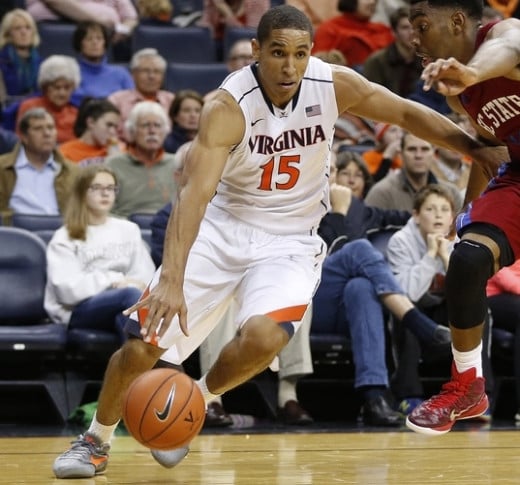
Virginia Cavaliers
2014-2015: 30-4, 16-2 in the ACC; lost to Michigan St. in the NCAA Round of 32
Preseason Projection: 4th in the ACC; NCAA Round of 32
Final Standing: Tie for 2nd in the ACC; NCAA Elite 8
Departures: Justin Anderson (12.2 ppg., 4.0 rpg., 45.2% 3pt.) was selected 21st in the NBA Draft; Darion Atkins (7.6 ppg., 6.0 rpg.) graduated.
Tony Bennett's Virginia Cavaliers have been historically good over the past two seasons, losing a total of four ACC games on the way to two regular season titles. They do lose their best perimeter player and their best rebounder and post defender, but the same could be said a season ago when Joe Harris and Akil Mitchell graduated. The team has disappointed in the NCAA Tournament, but there is plenty of reason to believe that their success could continue almost indefinitely.
London Perrantes has been incredibly efficient in his two years as Tony Bennett's point guard (he had a better than 3 to 1 assist to turnover ratio last season), but his shooting fell off last season after he caught fire during the second half of his freshman year (31.6% 3pt., after shooting 61.5% during that 11 game stretch). With the shorter shot clock, Bennett will need him to look for his shot more and regain his accuracy. The team's new best player, 6-5 senior Malcolm Brogdon (14.0 ppg.), will start by his side; he isn't an explosive athlete, but his is skilled and dependable. With a need for more urgency at the offensive end, backup point guard Devon Hall may see more playing time as a facilitator after playing sparingly as a redshirt freshman. Sophomore Marial Shayok has the potential to develop into an offensive weapon that will help replace Justin Anderson; while he doesn't have Anderson's strength or explosiveness, he is a smooth athlete with a fluid jump shot that can contribute at both ends of the floor. Bennett also adds 6-6 Tennessee transfer Darrius Thompson; he can't shoot, but he can do everything else at the offensive end and will fit in perfectly on defense.
The frontcourt will be anchored by two seniors. 6-8 Anthony Gill (11.6 ppg., 6.5 rpg.) was powerful and efficient last season, although he may have reached his potential, while 6-11 Mike Tobey (6.9 ppg., 5.1 rpg.) can likely do more, particularly as a post scorer. If anyone is going to replace the athleticism of Atkins, it will be Isaiah Wilkins; he showed great potential as rebounder and shot blocker in limited minutes as a freshman, and seems likely to be able to add strength as a sophomore. Senior Evan Nolte struggles with his shot as a junior (27.6% 3pt.); he isn't as athletic as the other frontcourt options, and has to be able to stretch the floor to warrant playing time.
UVA has been among the premiere defensive teams in the country each of the last four years, improving to 3rd in in field goal percentage defense a season ago thanks to Tony Bennett's version of the pack line defense and his consistent recruitment of long, athletic players. That defense will become even more imposing when offenses have 5 seconds less to get off a shot. However, as much as the 30 second shot clock will help the Cavaliers at the defensive end, it may kill them even more offensively. The team runs clock at that end as well; there is no great penetrator, and almost all of the offense is generated through passing. The team also didn't shoot well from behind the arc last year, and this would be a horrible year for that to continue. Even if they do begin to hit their 3's, shooting percentages over 40 percent from the floor will be highly unlikely for either team in Cavalier games. Look for another successful regular season for Tony Bennett and company, but expect their offensive limitations to keep their postseason ceiling artificially low.
December 11 Update: Malcolm Brogdon is quite simply a better player than I gave him credit for; he is a legitimate player of the year candidate. London Perrantes suffered a temporary setback with an appendectomy, but he has indeed rediscovered his shooting stroke (53.8% 3pt.). Marial Shayok is slowly becoming more assertive, and Darrius Thompson is stepping up and proving to be a much more dangerous offensive player than he had shown at Tennessee (he's shooting 38.9% from 3 seemingly out of nowhere). The offense may be just fine.
February 2 Update: The Cavaliers have more than righted the ship at the offensive end, with London Perrantes (51.9% 3pt.) emerging as one of the more dangerous three point threats in the country and taking pressure off of Brogdon at that end. Surprisingly, defense has emerged as a potential problem, as Justin Anderson’s remarkable strength and athleticism and Darion Atkins contributions in the post have been sorely missed. Defending the post has been the biggest issue; Isaiah Wilkins provides some of Atkins mobility, but he isn’t strong enough to hold his position or rebound as well as Atkins. This is still a very good team and may actually have a better shot at a postseason run because they can score and the defensive system will still be effective in the NCAA Tournament; however, the Cavaliers haven't been quite as imposing in conference play, particularly against teams with stacked frontcourts.
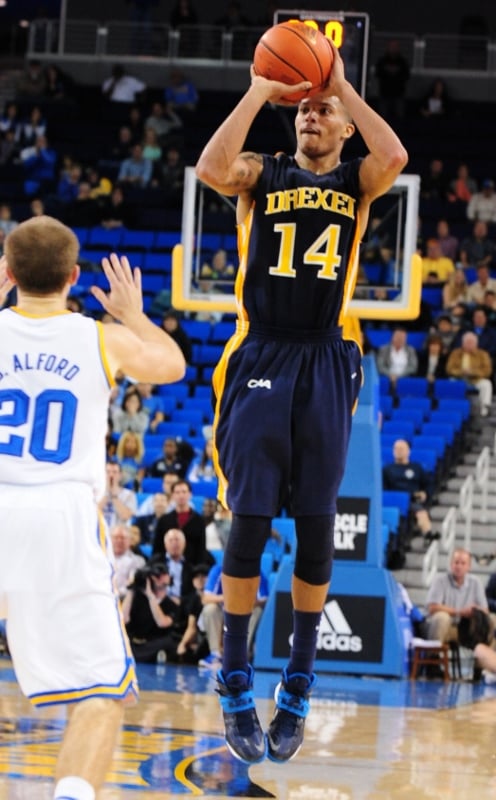
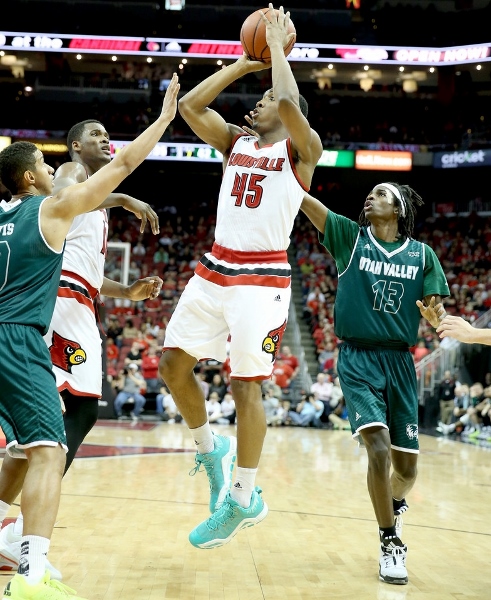
Louisville Cardinals
2014-2015: 27-9, 12-6 in the ACC; lost to Michigan St. in the NCAA Elite 8
Preseason Projection: 3rd in the ACC; NCAA Elite 8
Final Standing: 4th in the ACC; postseason ban
Departures: Terry Rozier (17.1 ppg., 5.6 rpg.) was selected 16th in the NBA Draft; Montrezl Harrell (15.7 ppg.9.2 rpg.) was selected in the 2nd Round; Wayne Blackshear (11.6 ppg., 4.3 rpg.) graduated.
Last year's Louisville Cardinals had remarkably little depth and could not shoot the 3, finishing 305th in Division I in 3 pt. percentage. After the dismissal of Chris Jones in February, Rick Pitino was forced to play his remaining perimeter players nearly 40 minutes per game. By contrast, he has an embarrassment of riches at his disposal this season, and every one of them is a serious threat from behind the arc. Like Grayson Allen at Duke, Quentin Snider had a very interesting freshman year in which he played remarkably little prior to Jones' dismissal, and was then asked to play almost every minute afterwards (9.3 mpg. before, 35.2 mpg. afterwards). His season was made even more challenging by the fact that almost all of those minutes required him to play off the ball. As a sophomore, he will be faced with a very different challenge, as he is the only true point guard on the roster. Fortunately, all of the shooting around him will make that a much easier proposition than it would have been a season ago. At shooting guard, Pitino adds Donovan Mitchell, a top 20 recruit that's a strong and athletic scorer; he could eventually start at shooting guard. Another option will be Trey Lewis, a 6-2 graduate transfer that averaged 16.3 points (on 42.3% 3 pt. shooting) and 4.4 rebounds at Cleveland State. While he has played off the ball in the past, he will see time at point guard as well. A fellow graduate transfer, 6-6 Damion Lee, should start at small forward; he was the premiere transfer available after averaging 21.3 points (on 38.5% 3 pt. shooting) and 6.1 rebounds per game at Drexel, and could emerge as a star at Louisville. Pitino also has 6-8 top 25 recruit Deng Adel, an elite athlete with a high motor that will be underweight as a freshman but is probably athletic enough to contribute. All five are dangerous three point shooters, which will create spacing that will in turn make everything easier on the offensive end.
Pitino is still overloaded with talent in the post as well. Both sophomore Chinanu Onuaku and Mangok Mathiang, the likely starters, are great per minute rebounders, and they're both better shot blockers than Harrell. The team was 13th in the country in blocks a season ago, and that may actually improve as that pair receives more minutes. The Cardinals also have a pair of top 70 recruits from last year in 7 foot project Anas Mahmoud (perhaps the best shot blocker of the bunch) and super athletic Jaylen Johnson, as well as 6-9 freshman Raymond Spalding, a top 40 recruit. What Pitino doesn't have is a polished post scorer to replace what Harrell provided at the offensive end. Of this group, the freshman Spalding appears the most skilled in that regard, but he may not be strong enough for big minutes as a freshman.
This team will present a very different set of challenges for Rick Pitino. They suddenly have an abundance of perimeter scoring but very little inside scoring, the exact opposite of last year's team. There is only 1 true point guard, where Pitino has had several at his disposal over the last few years. Finally, the team is also very young, with only 1 junior and the graduate transfers in the likely rotation. Regardless, the team will defend (the Cardinals were 23rd in field goal percentage defense a season ago), and the 30 second shot clock will only help a pressing defense that delays opponents from initiating their halfcourt offenses. The shorter shot clock also makes this a great year to have lots of shooters. Barring an injury to Snyder, the Cardinals are in position for yet another run in March.
December 11 Update: Damion Lee has met Rick Pitino’s high expectations, and Trey Lewis has exceeded them; the pair have formed a dynamic duo that will make Louisville hard to defend all year. Donavan Mitchell has come in ready to go as well. In the post, Chinanu Onuaku has become a foul waiting to happen. Fortunately, Mangok Mathiang has improved significantly, particularly at the offensive end. Anas Mahmoud has been the team’s most interesting player; he’s remarkably agile and skilled with the basketball, and the only potential limitation to his development is his need to add strength.
February 2 Update: Chinanu Onuaku has reemerged as a frontcourt star in Mangok Mathiang's absence due to a foot injury. The Cardinals struggled horribly to score against UVA in their blowout loss last week; Onuaku was ill during that game, and having two aggressive threats in the post upon Mathiang's return should help alleviate that problem.
February 19 Update: In light of their decision to skip the postseason in hopes of avoiding taking a hit to their recruiting class and potentially seeing several players transfer, Mangok Mathiang will not return until next season. Anais Mahmoud is out as well, but it all seems pointless because of what has become a lame duck season for the Cardinals.

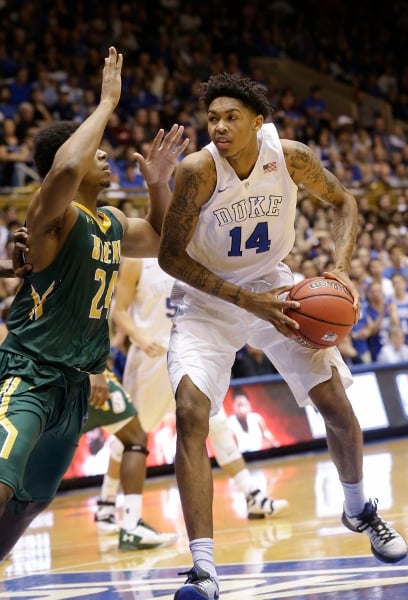
Duke Blue Devils
2014-2015: 35-4, 15-3 in the ACC; National Champions
Preseason Projection: 2nd in the ACC; NCAA Elite 8
Final Standing: Tie for 5th in the ACC; NCAA Sweet 16
Departures: Jahlil Okafor (17.3 ppg., 8.5 rpg.) was selected 3rd in the NBA Draft; Justice Winslow (12.6 ppg., 6.5 rpg., 41.8% 3pt.) was selected 10th; Tyus Jones (11.8 ppg., 5.6 apg., 37.9% 3pt.) was selected 24th; Quinn Cook (15.3 ppg., 39.5% 3pt.) graduated
This year's Duke Blue Devils will be an almost completely different group than the team that won last year's NCAA Championship. While that should temper expectations, it will nonetheless be very interesting to watch another talented group come together. There will once again be plenty of future professionals on the floor for Mike Krzyzewski, and there will be plenty of optimism to go along with them.
Last year's point guard duo of Cook and Jones will be replaced by a single incoming point guard in Derrick Thornton. Thornton is a top 15 recruit nationally that had to reclassify from the 2016 class to give the Blue Devils the point guard they were otherwise going to be completely without. He's a true point guard that sees the floor well and has the ability to score at each level- just what the doctor ordered for this particular group of Blue Devils. Thornton is also considered an elite defender, which should add a new wrinkle for Duke. Joining him in the backcourt will likely be Grayson Allen, a 6-4 former McDonald's All American that had a fascinating freshman year. Allen averaged 12.5 points in 19 minutes per game during the Final Four, as opposed to the 3.9 points he scored in 7.7 minutes per game the rest of the year. He's highly skilled, physically explosive, and extremely confident and aggressive, and no one is looking forward to this season more than he is. The only true veteran likely to see time on the perimeter for the Blue Devils is junior Matt Jones, a solid defender capable of hitting an open shot (37.6% 3pt.) that will do whatever Krzyzewski needs him to do. Also in the mix on the perimeter will be another McDonald's All American in 6-5 guard Luke Kennard; he's a strong three point shooter that, like Allen, handles the ball well enough that he should be able to help relieve pressure on Thornton. Small forward will belong to the most highly regarded recruit in the class, 6-8 Brandon Ingram. Already projected as a top 5 pick in next year's draft, Ingram has great length and a smooth jump shot, although he may have trouble with contact until he can add weight to his wiry frame. If everyone lives up to expectations, Duke could once again have enough outside shooting to simply outscore people at times.
While there are no immediate top 5 picks for Krzyzewski to turn to in the frontcourt, he does have three McDonald's All Americans and one of the most highly regarded transfers in the country. Sean Obi is only the fifth transfer Krzyzewski has ever accepted; he averaged 11.4 points and a dominating 9.3 rebounds per game as a freshman at Rice two years ago. While he may not be quite as skilled and agile as Okafor, at 6-9, 270 pounds, he should be able to replace Okafor's rebounding and hold his position defensively in the post. 6-10 freshman Chase Jeter, a top 15 recruit, will likely start by his side; he's already the team's best post scoring threat, and after bulking up to 240 pounds he should be able to help on the boards as well. 6-9 senior Amile Jefferson (6.1 ppg., 5.8 rpg.) is another option at power forward. While he did lose his starting job down the stretch a season ago, he's always been a solid per minute rebounder, and he's the only really experienced post player on the team. With 7-0, 255 pound senior Marshall Plumlee still around to provide an energetic and athletic large body, the Blue Devils will still have plenty of depth in the post.
It is a very real possibility that Derrick Thornton will come in and play well as a freshman, but keep in mind that last year's backcourt also featured a senior point guard playing off the ball, and that Thornton, unlike Jones, is supposed to be a high school senior. Offensive efficiency is going to drop (Duke was 13th in the country in assist to turnover ratio a season ago). There are likely to be many possessions this year where Grayson Allen is left to bail Duke out at the end of the shot clock (which, if you're a Duke fan, will probably be a lot of fun to watch- but it won't be particularly efficient). Duke was also 3rd in the country in overall field goal percentage; without an agile, skilled, 270 plus pound top 5 pick shooting over 66% from the floor, that number will drop as well. This will also be one of the youngest teams in the country, with only two players that have ever played extensive minutes for the Blue Devils before. Still, while it would be a stretch to consider this year's Blue Devils a favorite to repeat as National Champions, Mike Krzyzewski has reloaded quickly once again, and this team should be very dangerous by the time March arrives.
December 11 Update: Sean Obi is noticeably absent from Krzyzewski’s now characteristically short rotation, and more recently Chase Jeter has had trouble getting on the floor as well. That has to be a huge disappointment for Obi, who appears to have wasted two years that, if his freshman year at Rice was any indication, could have seen him develop into an NBA prospect by now if he had stayed put. Without Obi, and with Jeter struggling against stronger players, the Blue Devils are extremely vulnerable in the paint; add Brandon Ingram’s lack of physical strength, and Duke could get destroyed on the boards against several loaded ACC frontcourts. In the backcourt, Derryck Thornton looks like a very good high school player (which is exactly what he is supposed to be), but he isn’t ready to run the show for Duke, leaving the offense heavily dependent on the remarkable efforts of Grayson Allen. It’s working for now, but it’s not a recipe for success in single elimination tournaments, as everyone has an off shooting night now and then.
February 2 Update: After a slow start, Brandon Ingram has more than lived up to the hype for the Blue Devils, even contributing as a strong out of area rebounder. Unfortunately, reality has set in in the post, where he gets pushed around and can be kept off the boards when teams remember to get a body into him. Amile Jefferson's return can't come soon enough, but once he does the Blue Devils should once again be a tough out in the NCAA Tournament- although a title run seems unlikely without a true point guard on the floor to keep things moving on the offensive end. After finishing 31st in the nation in assists last season, Duke is down to 151st this year.
March 6 Update: Jefferson's inability to return from a broken foot lowers the ceiling on Duke's postseason chances. They should still be able to outscore one or two teams, but their vulnerability in the paint will likely catch up with them at some point.
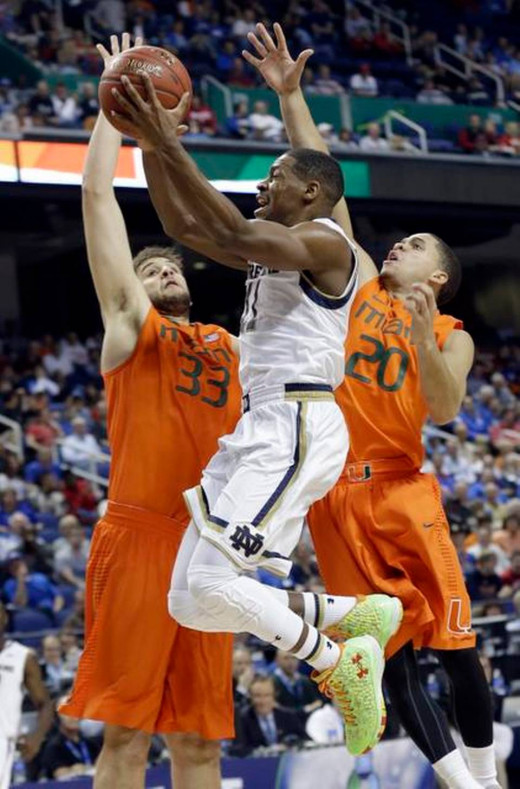
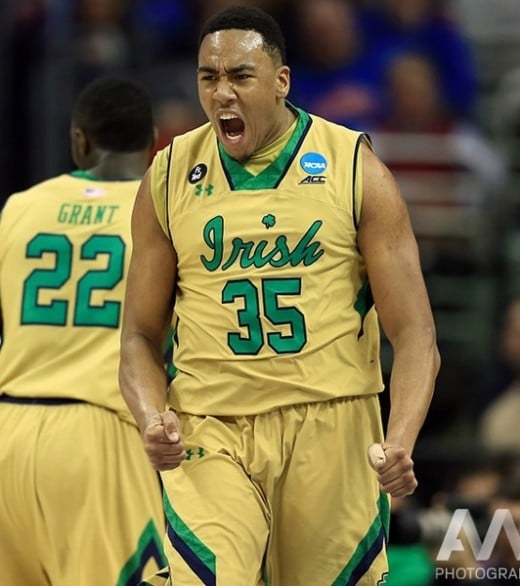
Notre Dame Fighting Irish
2014-2015: 32-6, 14-4 in the ACC; lost to Kentucky in the NCAA Elite 8
Preseason Projection: 9th in the ACC; NIT
Final Standing: Tie for 5th in the ACC; NCAA Elite 8
Departures: Jerian Grant (16.5 ppg., 6.7 apg.) was selected 19th in the NBA Draft; Pat Connaughton (12.5 ppg., 7.4 rpg., 42.3% 3pt.) was selected in the 2nd Round.
With Grant's departure, it will become the Demetrius Jackson show at Notre Dame, and if his sophomore year was any indication, that show should be tremendously entertaining. Jackson (12.4 ppg., 42.9% 3pt.) is as good as anyone in college basketball at attacking the basket off the dribble, and he can shoot and be disruptive defensively as well. Without Grant sharing the load and no real backup to speak of, Jackson will need to be on for close to 40 minutes a game for the Irish to be competitive. He will at least have great shooters on the wings that he can count on. Steve Vasturia (10.1 ppg., 41.1% 3pt.) is also in line for a breakout junior year; he's getting stronger, and he was already long, athletic, and increasingly confident. He's also good enough with the basketball that he may be able to relieve the pressure on Jackson at times. At small forward, 6-8 junior V.J. Beachum (41.6% 3pt.) will need to build on the success he had early in the season before his minutes dropped (7.5 ppg. in 17.2 minutes through 23 games, then 2.2 ppg. in 8.8 minutes over his last 10). He's physically tentative at times, but that could improve as he continues to get stronger. His competition for minutes will include 6-8 freshman Matt Ryan, another great shooter that ballooned to 6-8, 220 pounds with a late growth spurt and is already stronger than Beachum. If anyone has a chance to play a stretch four, it would be Ryan, but that would be a lot to ask of him physically as a freshman. 6-5 freshman Rex Pflueger, a top 100 recruit, should see plenty of minutes a well; he excels as both a passer and shooter, and could help the Irish remain somewhat efficient when Jackson is off the floor.
After a breakthrough junior year, 6-10 Zach Auguste (12.9 ppg., 6.5 rpg.) returns as the man in the middle for the Irish. He's a great post scorer when he's 1 on 1, and he's a strong defender in post isolation as well. Bonzi Colson is the most likely candidate to start at power forward; he's undersized and wasn't in great shape as a freshman, but he has very long arms and a high motor that allowed him to make a positive impact in the post once his minutes increased during the second half of the season.
Notre Dame finished 4th in the country in assist to turnover ratio, 2nd in overall field goal percentage, and 24th in 3 pt. % a season ago; simply put, they were the most efficient and prolific offensive team in the country. As great as Jackson can be (he's currently projected as a lottery pick next year), two point guards is better than one, and Jerian Grant was a great distributor. Playing without a stretch four will hurt as well, as floor spacing will suffer, making it more difficult for Jackson to drive and for Auguste to post up. Those offensive numbers are all likely to plummet. At the other end of the floor, Notre Dame improved to a respectable 89th in the country in 3pt. percentage defense after finishing 334th the year before; without Connaughton's athleticism and shot blocking ability at power forward (he played small forward two years ago) and Grant's length at point guard (he missed most of that year due to academics), that number seems likely to drop precipitously as well, which will be even more of a problem with teams likely to put up more threes due to the shorter shot clock. There is still plenty of talent here, but, while the Irish will still score and be fun to watch, Mike Brey may miss the NCAA Tournament for the second time in three years.
February 2 Update: V.J. Beachem (11.7 ppg., 4.2 rpg., 44.1% 3pt.) has gotten more assertive on the boards and, with Bonzi Colson’s emergence as the best supplemental big the Irish have had in a while, the Irish can suddenly compete on the glass. Unfortunately, as was to be expected after the departure of Pat Connaughton and Jerian Grant, the Irish are once again among the worst teams in the country defending the 3. Also, Demetrius Jackson (16.3 ppg., 4.8 apg.) has already played 38 plus minutes 9 times; if he gets into foul trouble (he’s finished 3 games with 4 fouls) or hurt, the team’s offensive efficiency will plummet. Still, on nights when he is available from start to finish, Notre Dame can score enough to stay close to anyone.
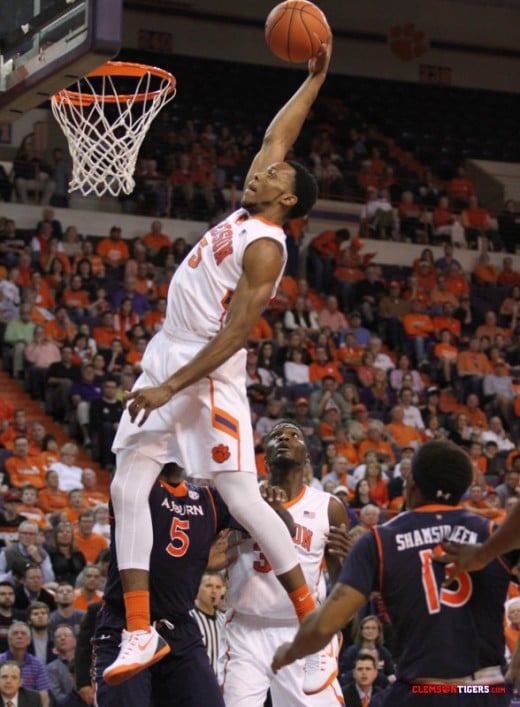
Clemson Tigers
2014-2015: 16-15, 8-10 in the ACC
Preseason Projection: 12th in the ACC
Final Standing: Tie for 7th in the ACC
Departures: Rod Hall (9.2 ppg., 3.4 rpg.) and Damarcus Harrison (7.9 ppg., 34.8% 3pt.) graduated.
Brad Brownell and the Clemson Tigers were able to climb to the middle of the pack and reach the NIT two years ago with K.J. McDaniels leading the team at both ends of the floor, but the team fell back to earth last season when they were unable to replace his contributions at the offensive end.
Clemson will have a completely new backcourt this season, and, depending on how quickly they adjust to the ACC and to each other, it could ultimately be an upgrade. The man with the ball in his hands will likely be freshman Ty Hudson, a top 100 recruit nationally. He's efficient at running an offense and strong, quick, and aggressive attacking the basket, the latter of which was something often missing from Rod Hall's game. Another point guard, junior San Francisco transfer Avry Holmes, should start by his side. In addition to being able to help Hudson run the offense, he's a 43.9% career 3 pt. shooter, which makes him an upgrade from anything the Tigers have had since Terrence Oglesby left in 2009. Senior Jordan Roper will come off the bench after struggling tremendously as a junior. He's a streaky shooter that brings a lot of energy and even a few two handed dunks when his shot is falling.
The development of their young and athletic forwards will be the most important determining factor in how good this Clemson team can be. 6-7 junior Jarrod Blossomgame (13.1 ppg., 8.2 rpg.) proved to be a great rebounder last season, and he's a quick and effective post scorer as well. 6-8 Donte Grantham (8.8 ppg., 4.6 rpg.) shot horribly as a freshman, but he's capable and athletic and should become more aggressive and contribute more on the boards as a sophomore. Both proved to be very willing three point shooters a season ago; if they could become reasonably accurate as well, then Clemson's offensive difficulties would become a thing of the past. 6-10, 255 pound senior Landry Nnoko (7.6 ppg., 5.4 rpg., 2.0 bpg.) struggled with fouls last year and his rebounding suffered as a result, but he is still a strong shot blocker when he's on the floor. Behind him, junior Sidy Djitte failed to build on the promise he showed as a freshman, but he's still an excellent per minute rebounder and improving shot blocker.
Again, as great of a defensive player as K.J. McDaniels was, it was his offense that Clemson really struggled to replace a year ago. The Tigers finished 245th in assist to turnover ratio and 325th in 3 pt. shooting percentage; having two point guards on the floor should help with the former, while the arrival of Holmes, the continued improvement of Blossomgame and Grantham, and a return to form for Roper and Ajukwa would address the latter. Hudson's aggression should open things up the offense for everyone. Brad Brownell teams will always defend; they were 56th in the country in field goal percentage a season ago, and will only be helped by the move to a 30 second shot clock. While they're too young to project as an NCAA Tournament contender, the potential is here for the Tigers to eventually be able to do just that.
December 11 Update: Freshman Ty Hudson still needs time to develop, which has left Jordan Roper and Avry Holmes to share point guard duties. They have been remarkably efficient with the basketball, and Holmes has been as good as advertised shooting the 3. Donte Grantham has taken a step forward, while Jaron Blossomgame has become a star at the offensive end. Both have shot better from the perimeter, meaning the team has four dangerous shooters on the floor for most of the game. Sidy Djitte has become a reliable presence on the boards, but beyond his contributions depth is a serious concern.
February 2 Update: Everything has come together for the Tigers in ACC play. Brad Brownell has found a strong seven man rotation that works, with Sidy Djitte and 6-3 sophomore guard Gabe DeVoe growing increasingly confident and productive as the season goes along. The starting backcourt of Jordan Roper and Avry Holmes has remained efficient even against ACC competition, and Roper has even started to find his jump shot again. Clemson’s schedule gets much easier down the stretch; if they continue to play as well as they have, they should find themselves in the NCAA Tournament for the first time since Brownell’s first year at the school in 2011. The Tiger’s had a horrible non-conference showing to make up for, but it appears they will be the ACC’s surprise success story.
February 19 Update: After a watershed January, Clemson has likely squandered its opportunities for an NCAA Tournament berth with bad road losses to Virginia Tech and North Carolina St.. Unless they can win the rest of their games (which includes a home game against Virginia) and win a game in the ACC Tournament, it may be back to the NIT for the Tigers.
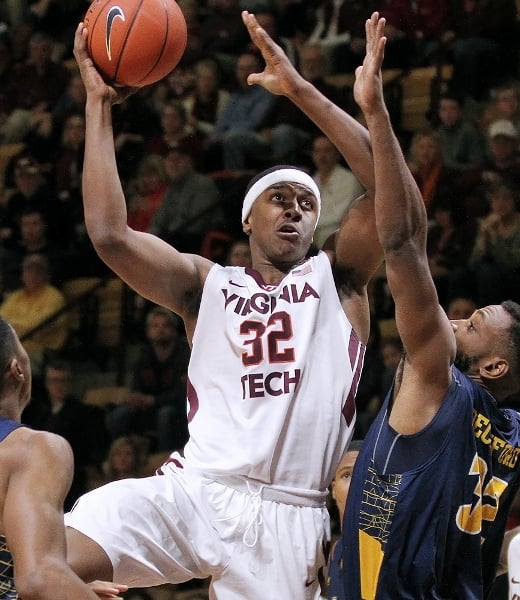
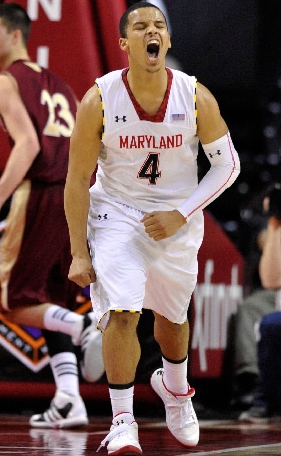
Virginia Tech Hokies
2014-2015: 11-22, 2-16 in the ACC
Preseason Projection: 13th in the ACC
Final Standing: Tie for 7th in the ACC; NIT
Departures: Adam Smith (13.4 ppg., 42.4% 3pt.) transferred to Georgia Tech.
Virginia Tech was woefully undersized in Buzz Williams' first season as head coach, and there was really nothing he could do to allow his team to compete defensively or on the boards. The Hokies finished 223rd in Division 1 in field goal percentage defense and 337th in rebounding margin. The rebounding margin in particular represents a remarkable level of futility for an ACC team. A year of physical development and a second quality recruiting class will help, although a complete answer to those problems is still likely a year away.
Offensive efficiency is normally a hallmark of Buzz Williams teams, but with a roster featuring just one upperclassmen, the Hokies struggled to finish 158th in assist to turnover ratio last season. While that isn't good, it was a huge improvement from finishing 284th in James Johnson's final year as coach. The much anticipated arrival of Maryland transfer Seth Allen (13.4 ppg., 3.0 apg., 38% 3pt. before transfer) a redshirt junior, should help. Allen isn't a true point guard and could spend significant time off the ball, but he will represent an offensive upgrade to Adam Smith in the backcourt. Last season's starting point guard, 6-4 junior Devin Wilson (6.5 ppg., 4.2 rpg.), struggled with his perimeter shot, but he did take very good care of the basketball and finished with a better than 2 to 1 assist to turnover ratio. He could lose minutes to Allen and freshman Justin Robinson, a top 90 recruit that's already a better creator than Wilson but also can't shoot from the perimeter. Last season's top recruits, 6-5 guards Justin Bibbs (11.4 ppg., 41.3% 3pt.) and Ahmed Hill (8.7 ppg., 38.6% 3pt.), lived up to expectations as freshman and give the team physically capable wings that are dangerous behind the arc. 6-6, 205 pound freshman forward Chris Clarke is the most highly regarded of the freshmen as a top 60 recruit. He's raw offensively, but his athleticism and non-stop effort will likely make him an immediate contributor defensively and on the boards. While there are a lot of perimeter options, there should be enough minutes to go around as the lack of depth in the frontcourt will again force Williams to continue playing four perimeter players and just 1 big most of the time.
Easily the most important addition for the Hokies is 6-10, 240 pound forward Kerry Blackshear. A top 100 recruit, he may need to add strength before he completely fulfills his potential, but he's mobile, tough, and a capable post scorer that should at least be able to rebound his position as a freshman. He instantly increases the number of Hokies that can provide that from 0 to 1. Satchel Pierce received playing time as a freshman mostly because he's 7-0, 255 pounds and the team had no size. Now the team has almost no size, and he is still 7-0, 255 pounds, so it appears likely that he will continue to receive minutes. He can at least block the occasional shot and grab the occasional rebound. 7 foot junior college transfer Johnny Hamilton could see time and would be the most likely player to provide a shot blocking threat, but he is extremely raw, Shane Henry, who was a dominant and exciting rebounder and shot blocker in junior college, simply wasn't strong enough to be an effective front court player in the ACC. He has added 25 pounds since joining the Hokies; if he could take a large step forward, he could drastically improve Virginia Tech's outlook.
With physically maturing young players and the additions of Clarke and Blackshear, the Hokies should improve upon last season's futility rebounding and defending, although not to the point that it could be considered a strength. With the addition of Allen, offense should come easier as well, and the new 30 second shot clock should benefit a team playing 4 perimeter players- at least at the offensive end. This shouldn't be a bad team by any stretch, and the improvements should be easily quantifiable, but the ACC is very strong once more and it isn't a good place to play if you're seriously undersized. Buzz Williams may need to wait one more season before he can begin to contend in the ACC.
December 11 Update: This is a very, very different Virginia Tech team than could have been expected. After producing very little at South Florida, junior transfer Zach Leday has been a monster inside (15.1 ppg., and an impressive 9.1 rpg.), playing much larger that his 6-7, 235 pound frame. Kerry Blackshear and (currently suspended) college transfer Johnny Hamilton have been productive immediately as well, and suddenly Virginia Tech can in fact compete in the paint. Throw in Chris Clarke’s incredible efforts at small forward (10.9 ppg., 7.9 rpg.), and this may be one of the better rebounding teams in the conference. Unfortunately, the potential redshirt of an injured Ahmed Hill has been a major setback; Justin Robinson and Seth Allen have come in shooting horribly, and the result is that the Hokies have exactly the opposite problem from what should have been expected. Still, Jalen Hudson, Justin Bibbs, and Devin Wilson give Buzz Williams enough consistent options in the backcourt that the Hokies may be very competitive once conference play begins.
February 2 Update: Chris Clarke's injury and Zach Leday's decision to become a perimeter player on offense have hurt the Hokies in conference play. Still, it's a young team that, with the return of Clarke and Hill, will be very dangerous in the ACC a season from now.
February 21 Update: Clarke's return means the Hokies have a chance to close the season strong. An NIT appearance would represent a huge step forward in Buzz Williams' second year at Virginia Tech.
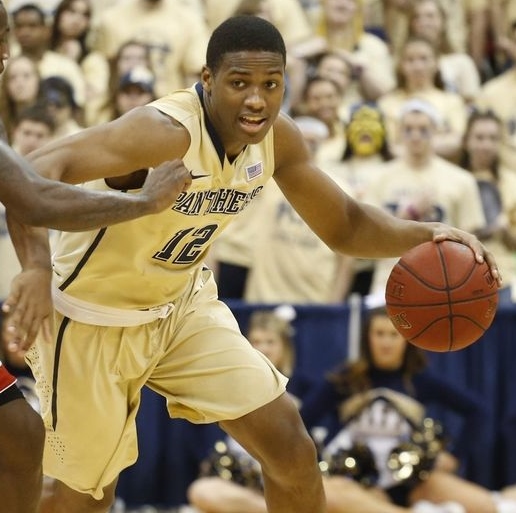
Pittsburgh Panthers
2014-2015: 19-14, 8-10 in the ACC; lost to George Washington in the NIT First Round
Preseason Projection: 6thth in the ACC; NCAA Round of 32
Final Standing: Tie for 9th in the ACC; NCAA Round of 64
Departures: Cameron Wright (9.3 ppg.) graduated; Josh Newkirk decided to transfer.
The 2014-2015 season was a disastrous one for Pittsburgh- if only in terms relative to the rest of the Jamie Dixon era. The team failed to make the NCAA Tournament for only the second time this century, although an NIT appearance would be a major accomplish for most Division I programs. With just two rotation players departing and four promising newcomers, including three with previous Division I success, the Panthers have reason for optimism going into this season.
While he may not be much of a weapon, senior point guard James Robinson (8.9 ppg., 5.1 apg.) is tremendously efficient with the basketball. His shooting regressed as a junior (29.8% 3pt.), but hopefully better spacing will remedy that. Freshman point guard Damon Wilson Jr., Jamie Dixon's first top 100 recruit in two years, should replace Josh Newkirk as Robinson's backup if he's eligible. He isn't much of a shooter either, but at 6-5 he should eventually be able to contribute more at the defensive end. Shooting guard will likely belong to 6-4 graduate transfer Sterling Smith (13.9 rpg., 41.8% 3pt.) from Coppin St.; a second team all conference player in the MEAC, he's a huge upgrade to Wright as a perimeter shooter, and he's also a tough player at the defensive end that averaged nearly five rebounds a game as a junior. After excelling offensively but struggling to defend larger players at power forward last season, 6-7 junior Jamel Artis (13.6 ppg., 6.0 rpg., 39.4% 3pt.) could be a star playing small forward thanks to additions to the frontcourt, After having a breakout season offensively as a sophomore, 6-6 Chris Jones (8.5 ppg., 35.7% 3pt.) may lose his starting spot, but he will be an important offensive contributor on the wing.
The Panthers finished last season 270th in the country in field goal percentage defense due in large part to an undersized frontcourt. That should change with the addition of two established graduate transfers. The likely starter at center will be 6-9, 245 pound Brown transfer Rafael Maia; he led the Ivy League in rebounding a season ago with 8.7 rebounds per game, and should be able to hold his position in the the post and help control the boards defensively.. 6-9 transfer Alonzo Nelso-Ododo will offer a potential shot blocking presence off the bench after averaging 2 blocks over 23 minutes per game in his 3 seasons at Richmond. Like Artis, 6-9 junior Michael Young struggled to defend larger players while playing out of position at center, but he rebounded well and proved to be a dangerous and efficient post scorer (13.4 ppg., 7.3 rpg.). He should excel at power forward. While not nearly as assertive as the starters, senior Sheldon Jeter and sophomore Ryan Luther can at least provide more outside shooting off the bench.
Scoring should not be a problem for this Panthers team. They finished 3rd in the country in assist to turnover ratio a season ago; the loss of Newkirk may hurt, but with Wright's departure and another capable outside shooter arriving to take at least some of his minutes, offensive should still be a strength. More importantly, last season's defensive struggles should end with experienced, capable size joining the frontcourt, and rebounding could be a strength with Artis at small forward. A return to the NCAA Tournament is a very real possibility for Pitt; After starting to struggle with high school recruiting, Jamie Dixon seems to have righted the ship by recruiting transfers that fit into his system, and last year's failure of sorts should prove to be an aberration.
February 2 Update: Pittsburgh’s glass house is falling in ACC play, Their non-conference success was misleading, as their only opponent from a major conference was Purdue, who they lost to by 13 points at home. The graduate transfer imports have not fared particularly well, as Sterling Smith has been passive at the offensive end and Maia and Ododo have failed to solidify the center position. The Panther’s ACC schedule is backloaded, so it will be a challenge for them to hold on to their current position as a likely tournament team.
February 29 Update: Inserting a confident and aggressive Chris Jones into the starting lineup in place of a passive and hesitant Sterling Smith has made a huge difference for the Panthers at the offensive end, as has the emergence of Ryan Luther as a scoring threat off the bench. With newfound offensive punch, the Panthers are suddenly a dangerous NCAA Tournament team coming off important wins against Syracuse and Duke in their last three games.
March 14 Update: Despite being the lower seed, the Panthers have a favorable first round matchup with a Wisconsin team that doesn't have quite as much talent as they have over the past few years. Pitt should have a strong rebounding advantage against the Badgers, who have struggled with offensive efficiency for most of the season.
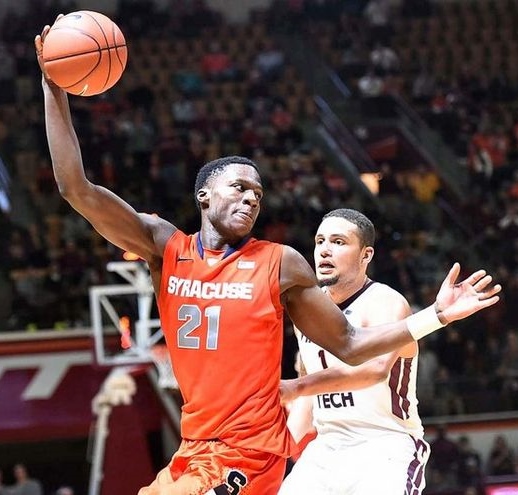
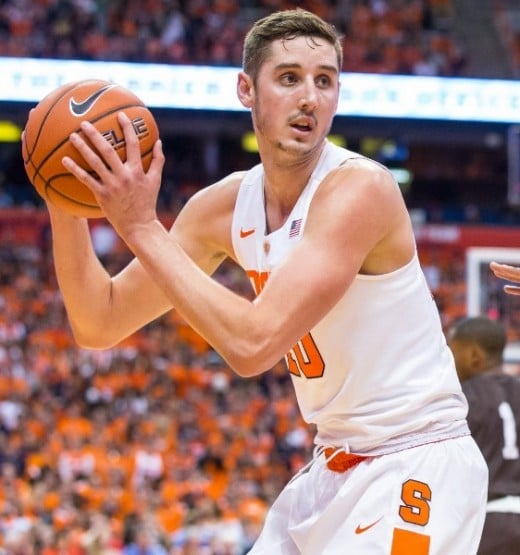
Syracuse Orange
2014-2015: 18-13, 9-9 in the ACC
Preseason Projection: 8th in the ACC; NCAA Round of 64
Final Standing: Tie for 9th in the ACC; NCAA Final 4
Departures: Rakeem Christmas (17.5 ppg., 9.1 rpg., 2.5 bpg.) was selected in the 2nd Round of the NBA Draft; Chris McCullough (9.3 ppg., 6.9 rpg. 2.1 bpg.) was selected 29th overall.
This will be the first of four seasons during which Syracuse will have only ten scholarship players (as opposed to the usual 13) as a result of penalties levied against the program by the NCAA as the result of an academic scandal. That being said, the cupboards are far from bare for Jim Boeheim and company, who welcome a strong recruiting class that remained loyal to the program after the punishment was announced.
What the Orange were able to accomplish a season ago was really quite remarkable considering how much freshman point guard Kaleb Joseph struggled. After losing Michael Carter Williams and Tyler Ennis in back to back NBA Drafts, Joseph came in significantly less heralded but as the only show in town. He shot horribly and didn't do much to create for teammates either. He will likely come off the bench this season; with a year in Boeheim's system under his belt and much, much more talent around him, things should be much easier for him when he does get back on the floor. Reason number 1 why the Orange were able to tread water (and even managed to finish a solid 43rd in the country in assist to turnover ratio) was the emergence of Michael Gbinije (12.7 ppg., 5.0 rpg., 3.6 apg., 39.2% 3pt.). He had a breakthrough year offensively, and was really the team's point guard by the end of the season. That appears to be where he will start as a senior. With the exception of Gbinije, Syracuse also struggled to shoot from the perimeter a season ago, finishing 322nd in the nation in 3pt. field goal percentage. That problem should be more than addressed by the freshman class, lead by 6-6 top 20 recruit Malachi Richardson. Richardson has a reputation as a great shooter, and will be able to help take care of the ball as well. A second 6-6 guard, Franklin Howard, will provide even more support for Gbinije; a top 90 recruit, he's more of a slasher than Richardson. Senior Trevor Cooney was a big reason the team shot so poorly a season ago; he hit 19.2% of his threes over the team's final 10 games on an average of 7.8 attempts. Considering the length and athleticism of the incoming freshman, it wouldn't be a tremendous surprise to see his minutes plummet, or to see him turn into what Bill Simmons would call a heat check guy off the bench.
As great as Christmas was, Syracuse would not have been able to stay afloat in the ACC had it not been for the emergence of Tyler Roberson following Chris McCollough's knee injury. While he isn't going to block many shots, at 6-8 he's tenacious on the boards, and his scoring should improve this season as well. His development becomes even more important as a late decision by top 60 recruit Moustapha Diagne to attend a two year college leaves the Orange very thin in the frontcourt and Roberson as the team's only real chance to compete in the paint. Dajuan Coleman, a former top 15 recruit, will be the likely starter at center. He has gotten down to 255 pounds, but his knees have been unable to support his frame to this point, and he already has multiple surgeries under his belt. With so few options available, Tyler Lydon, a 6-9 top 70 recruit with NBA range, will likely recieve playing time at both forward spots. He is mobile and will definitely help stretch the floor, but he may have trouble with contact as a freshman at only 205 pounds. The Orange weren't a dominant rebounding team last year, but Christmas and Roberson kept them respectable; without Christmas, it's a very real possibility it could become a problem this season.
This will be a very different Syracuse team than it was a year ago. With an influx of perimeter shooting and the loss of Christmas inside, the offense will literally be turned inside out - which may be a good thing with a shorter shot clock. Defensively, all of the length on the perimeter, including a 6-7 starting point guard, should make the Syracuse zone as effective as ever, particularly in defending the three. However, there will be very little rim protection as there is no real shot blocking threat, and closing out possessions could be a problem due to a lack of rebounding. Overall, while the Orange aren't likely to contend for a conference title, as long as Jim Boeheim has his freshman ready to play he may once again overcome off the court adversity to lead his team to the NCAA Tournament.
December 11 Update: Tyler Lydon has been productive immediately as a freshman, including being surprising competitive on the boards (7.1 per game). However, in the team’s first loss to Wisconsin in the ACC Big- Ten Challenge, he was asked to spend almost the entire game at center, and to no one’s surprise he was pushed around and the Orange were beaten up inside. If that were to continue into ACC play, the Orange simply will not be able to guard the post or compete on the boards. While Dajuan Coleman doesn’t exactly look spry, he is in good shape, he’s rebounding well, and he is definitely strong enough to hold position against large post scorers. He has to be trusted for at least 20 minutes a night at center for Syracuse to be able to competed in the ACC. Otherwise, Trevor Cooney has continued to struggle with his shot, but with so much inexperience he’s still needed on the floor for what he provides defensively and setting up the offense. He is quite simply the most active player Syracuse has at times; the Orange need him to find his shot again as well.
February 2 Update: With both Trevor Cooney and Malachi Richardson now finding their shooting stroke on most nights and Dajuan Coleman contributing as a post scorer, the Orange are now in solid position to return to the NCAA Tournament after a one year absence.
March 14 Update: The Orange were essentially gifted a bid into the NCAA Tournament, but face a difficult first round matchup with Dayton. Still, a hot shooting streak and non-conference teams unaccustomed to their defense could make a postseason run a possibility.
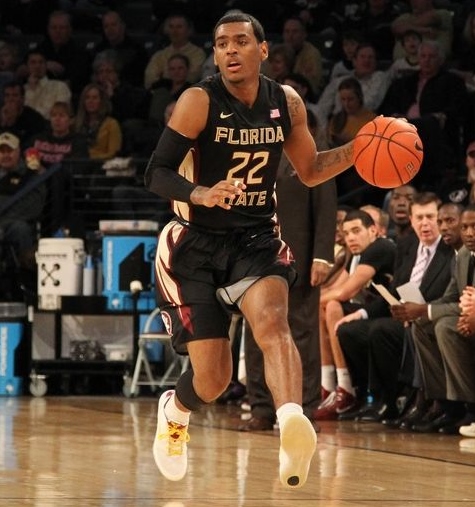
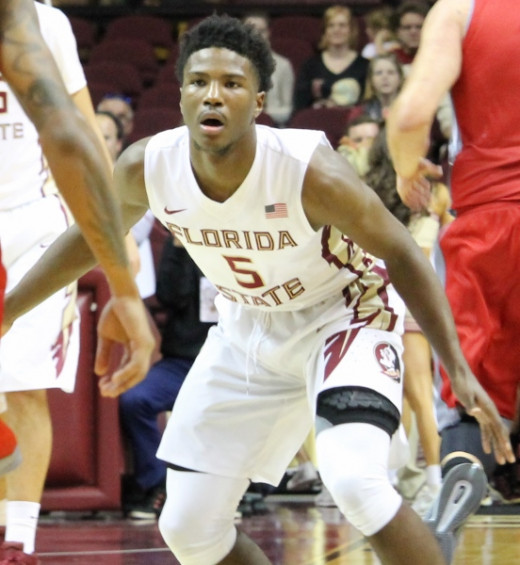
Florida State Seminoles
2014-2015: 17-16, 8-10 in the ACC
Preseason Projection: 9th in ACC; NIT
Final Standing: Tie for 11th in the ACC; NIT
Departures: No major departures.
After back to back NIT appearances, Florida State found itself on the outside looking in at both major tournaments last season. The hope is that with Leonard Hamilton's most talented recruiting class in years joining an experienced group that didn't lose any major contributors the Seminoles will be able to climb back to the middle of the pack in the ACC.
Florida State is routinely one of the least efficient offensive teams in the country (down to 303rd in assist to turnover ratio a season ago). They will once again be without any sort of real point guard, but a freshman class loaded with perimeter scorers added to last year's starting trio should provide some combination of players that will eventually be able to put points on the board. 6-4 Xavier Rantham-Mayes (14.9 ppg., 3.9 rpg., 4.3 apg.) found the ball in his hands earlier than expected as a redshirt freshman. He shot the ball seemingly at will, and the results were inconsistent (28.1% 3pt.). He should benefit from having more talented players in the backcourt with him. The most highly regarded of those are Dwayne Bacon, a 6-6 top 20 recruit, and Malik Beasley, a 6-4 top 30 recruit. Both are tremendous athletes that excel at attacking the basket and creating their own shot- exactly the sort of players that excel in Florida State's stale offense. Senior Devon Bookert (10.1 ppg., 39.3% 3pt.) did at least shoot the ball well from the perimeter a season ago, but his minutes could diminish with the influx of talent. Fellow senior Montay Brandon (11.8 ppg., 5.5 rpg.) struggled with his shot as well; unless Bacon ends up on the wing, at 6-7 he's the most logical choice for small forward, particularly after leading the team in rebounding a season ago. Terrance Mann, a third athletic top 90 recruit at 6-5, could earn time as well.
The biggest addition to the frontcourt, both literally and figuratively, could be 7-4 Jean Marc Christ Koumadje; while a work in progress, he is noted as being unusually mobile and well coordinated for someone his size, and could slingshot 7-3 senior Boris Bojanovsky to eventually start at center. Either way, Bojanovsky will get his minutes as well; while he has continued to add strength, his ceiling has always been limited. Phil Cofer was able to win the starting power forward spot as a freshman despite only carrying 205 pounds on his 6-8 frame; with added weight, he could provide a great deal more defensively and on the boards. 6-9 junior Jarquez Smith is still around as well; he hasn't lived up to his billing as a top 80 recruit, but if the light does come on he would provide an athletic stretch four.
The move to a 30 second shot clock should benefit Florida State. Again, Leonard Hamilton's offense is inefficient and lacks creativity, often relying on one of their perimeter players to make something happen for himself. It's bad offense, but it's just the sort of bad offense that doesn't require much time to develop- and it should benefit greatly from this year's freshman class. At the other end of the floor, the Seminoles are usually among the nation's best in terms of field goal percentage defense- although they were an abnormally low 115th in the country a season ago, down from 24th in 2013-2014. That should prove to be an aberration, particularly if Cofer is able to add strength at power forward, Koumadje can contribute immediately, and Hamilton takes defense into account in determining his perimeter rotation. Depending on how quickly the freshmen develop, Leonard Hamilton could lead the Seminoles back to the NCAA Tournament for the first time since 2012.
December 11 Update: FSU’s young perimeter has been immediately prolific, but the frontcourt has been a mess. Defense and rebounding are going to be a problem all year, and the offense will of course have efficiency problems once ACC play begins. It could be a surprisingly long year for the Seminoles.
February 2 Update: The injuries to Phil Cofer and Michael Ojo leaves Leonard Hamilton with remarkably few options in the frontcourt. The Seminoles are tentatively inside the bubble right now, but they will have to win a few tough games down the stretch to stay there. Jarquez Smith has shown signs of waking up, but everything is likely to depend on the loaded young perimeter.
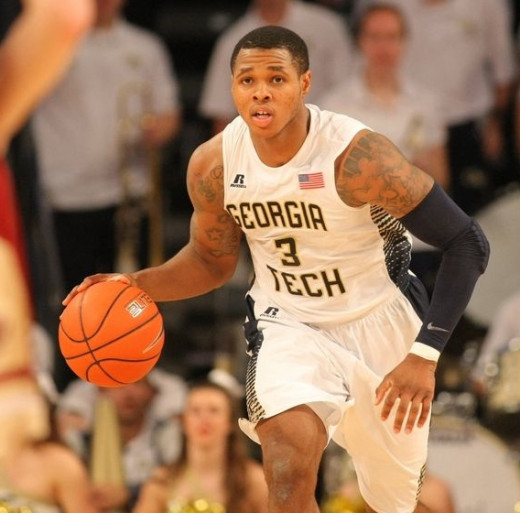
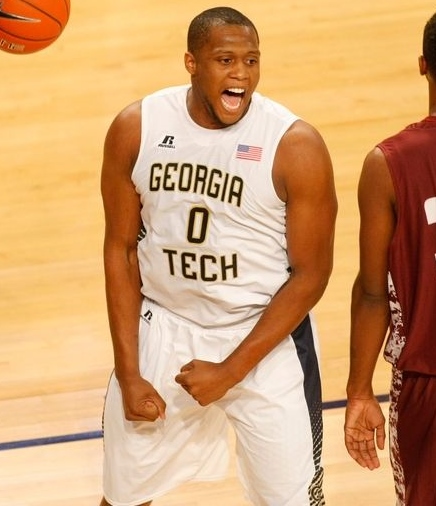
Georgia Tech Yellow Jackets
2014-2015: 12-19, 3-15 in the ACC
Preseason Projection: 14th in the ACC; postseason coaching change
Final Standing: Tie for 11th in the ACC; NIT; postseason coaching change
Departures: Demarco Cox (8.8 ppg., 6.1 rpg.) and Robert Sampson (5.5 ppg., 6.5 rpg.) graduated.
Georgia Tech has gotten worse each season under Brian Gregory, and there is little reason to believe that pattern will end now.
Point guard was always a strength for the Yellow Jackets during the Cremmins and Hewitt tenures, but it has become a real problem under Brian Gregory. Last year's underwhelming tandem of Travis Jorgenson and Josh Heath returns, and there is little reason to believe the team will significantly improve on last season's assist to turnover ratio, which ranked 232nd in Division I. The offense will at least be aided by the addition of Virginia Tech graduate transfer Adam Smith (14.4 ppg., 42.4% 3pt.), who will represent a significant upgrade at shooting guard. Sophomore Tadric Jackson (27.4% from the field, 17.8% from 3), a top 90 recruit last year, was obviously raw offensively as a freshman, but he's a superior athlete and, with an offseason to work on his game, could at least earn more playing time. The team's best player will again be 6-5 senior small forward Marcus Georges-Hunt (13.6 ppg., 5.5 rpg.), who might have shown up on the NBA's radar with more development and more talent around him. Junior Quinton Stephens looked as though he might have improved early last season, but he may never be strong enough to be a major contributor.
In the post, 6-8, 270 pound Charles Mitchell (9.8 ppg., 7.0 rpg.) was the team's savior a season ago-at least, as much as team that finishes next to last in conference can have a savior. He's simply a bull in the post; he's still quite foul prone, but he was a prime reason why the team was able to finish 12th in the country in rebounding margin last year. 6-8, 260 pound transfer Nick Jacobs (8.5 ppg., 3.5 rpg. prior to transfer), a former top 90 recruit from Alabama, will get the first opportunity to start by his side. He's never rebounded well despite his size, but, like Demarco Cox last year, it's possible he could take that cue from Mitchell. A second graduate transfer, 6-8 James White (11.9 ppg., 6.6 rpg. At UALR) from Arkansas Little Rock, will also have a chance to start beside Mitchell, and 6-10 sophomore Ben Lammers will be in the frontcourt mix as well.
It's more than a little surprising that Brian Gregory is back for a fifth season at Georgia Tech. They don't defend (226th in field goal percentage defense a season ago) or take care of the basketball (232nd in assist to turnover ratio). More importantly, players have completely failed to develop beyond what they were able to do as freshman, with Marcus Georges Hunt being the prime example (10.8 ppg., 4.9 rpg., 42.6% fg., 33.3% 3pt. as a freshman; 13.6 ppg., 5.5 rpg., 43.1% fg., 28.8% 3pt. as a junior). It's the same for almost everyone that has played at the school during his tenure. Seriously, check it out. Tadric Jackson would be an unnecessary test case, but it would be almost impossible for him not to improve. As it is, this team is going nowhere fast, and if it wasn't for BC this season could be historically ugly with the 30 second shot clock exaggerating the margins of defeat.
February 2 Update: There continues to be extremely limited player development for the Yellow Jackets, but the addition of Adam Smith as a consistent perimeter threat was enough to make the Yellow Jackets significantly more competitive. It also opened the lane up for Marcus Georges-Hunt, who has taken over the reigns at point guard. The postseason still seems unlikely for the Yellow Jackets, and, with no reason to be optimistic about next year’s recruiting class, this should still end Brian Gregory’s tenure at Georgia Tech.
February 21 Update: It will be interesting to see if a NIT berth will be enough to extend Brian Gregory's tenure at Georgia Tech. With Marcus Georges-Hunt, Charles Mitchell, Adam Smith, Nick Jacobs, and James White set to graduate and very little new talent coming in to replace them, it should be difficult for anyone to interpret a postseason appearance as a sign that the program is about to turn the corner.
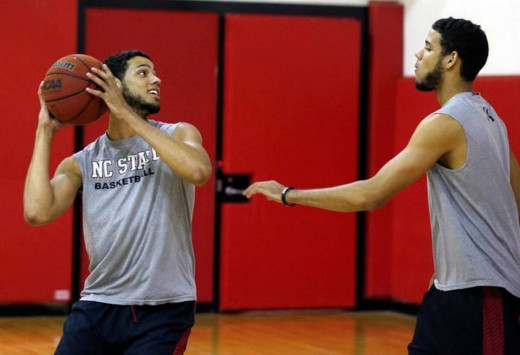
North Carolina State Wolfpack
2014-2015: 22-14, 10-8 in the ACC; lost to Louisville in the NCAA Sweet 16
Preseason Projection: 7th in the ACC; NCAA Round of 64
Final Standing: 13th in the ACC
Departures: Trevor Lacey (15.7 ppg., 4.6 rpg., 3.5 apg., 39.2% 3pt.) left to play professionally overseas; Ralston Turner (12.8 ppg., 36.7% 3pt.) graduated; and Kyle Washington (6.8 ppg., 4.1 rpg.) transferred to Cincinnati.
Of the ACC teams that made deep NCAA Tournament runs last March, NC State was the only one to both lose several key players and fail to land a strong recruiting class, although the late addition of Maverick Rowan does save them to a certain extent.
Anthony Barber (12.1 ppg., 3.7 apg., 38.0% 3pt.) will again be counted on to play huge minutes and to stay out of foul trouble as the team's lone point guard. He became a much more dynamic offensive player as a sophomore, and could pop up on the radar of NBA scouts if he continues to improve. Barber will have to be successful creating off the dribble if the Wolfpack is going to be able to score inside. It appeared as though that might become very difficult due to a lack of spacing after the graduation of Lacey and Turner, but the addition of Rowan changes that. A 6-7, 190 pound top 40 recruit that reclassified from the class of 2016, Rowan may not start, but he will be very important to the team as a replacement for some of Turner's offense. He will likely get pushed around due to a lack of physical strength as a freshman, but he's feisty and, most importantly, he's an elite shooter from deep and from the midrange. With his ability to create space off the dribble, he could become Barber's best outlet as the 30 second shot clock expires. At shooting guard, 6-4 junior West Virginia transfer Terry Henderson (11.7 ppg., 37.6% 3pt. before transferring) will be a solid contributor that will also help space the floor, but he isn't nearly the offensive player that Lacy was; he isn't as good of a shooter, and he won't be able to help Barber as much with regards to playmaking and distribution. The most important variable for this team will be the development of twin sophomores Caleb and Cody Martin. Caleb, a top 50 recruit a season ago, showed a great deal of potential at the defensive end in extensive minutes as a freshman despite missing two months of practice time with a broken foot before the season. He could start at small forward, and it also seems likely that he could see time as an undersized power forward due to a lack of depth in the frontcourt. Cody, a top 75 recruit a year ago, played sparingly as a freshman, although his role did temporarily expand when Barber missed time with an injury. Both players, particularly Cody, will benefit from a year in the weight room, and both will need to score and help take care of the basketball.
Mark Gottfried's options are suddenly limited in the frontcourt. A top 40 recruit a year ago, Abdul-Malik Abu (6.4 ppg., 4.8 rpg.) is a high motor athlete that is somewhat undersized and a work in progress at the offensive end. That development needs to come quickly, as he clearly has the most potential as a post scorer. Junior Lennard Freeman (5.6 rpg.) is an enforcer type that will have to recover quickly and smoothly from a broken leg suffered in June for the Wolfpack to be successful in their non-conference schedule. Beejay Anya (4.3 rpg., 2.5 bpg. in 19.4 minutes) significantly improved his conditioning as a sophomore, and he became the best per-minute shot blocker in the country. Still, it seems likely that his frame will always serve to limit his minutes. Although Gottfried apparently felt differently, Washington was the best prospect in the group; he was longer and more skilled than Abu, and he was a capable shot blocker as well, but he inexplicably fell almost completely out of the rotation late in the season.
NC State must have been caught off guard by the departure of Kyle Washington and Trevor Lacey, even though Washington was far too talented to be anyone's fourth big. Still, the late addition of Rowan will help, and Abu and the Martins should improve. The team defends well (60th in field goal percentage defense a season ago), and the 30 second shot clock should be a net gain. If there are any injuries, or if there are any complications in Lenard Freeman's recovery from a broken leg, the Wolfpack would be in serious trouble, but Mark Gottfried made a late recruiting save that may allow the Wolfpack to return to the NCAA Tournament for a fifth straight year.
December 11 Update: Anthony Barber has taken a completely different approach at the offensive end, and he has been tremendous- except for shooting the basketball, where he is 37.6% overall and has seemingly forgotten how to shoot the 3 (0 for 9 on the season) after shooting a respectable 38% behind the arc a season ago. It has become necessary for him to force things in the paint because Abu has not developed offensively and the team has no low post scoring threat whatsoever. The Martins have improved significantly, with Caleb emerging as the team’s best perimeter threat. Maverick Rowan has struggled with consistency shooting the basketball and lacks physical strength at this point, but he does manage to make good things happen. Everything will come easier once Terry Henderson returns from his ankle injury, and that should happen in time for the team to compete in conference play, but for now the team is struggling with only seven players that belong on the court.
February 2 Update: It appears that Terry Henderson may have decided he would rather return to the Wolfpack next season when they will likely be absolutely loaded, leaving this year's team to struggle for respectability.
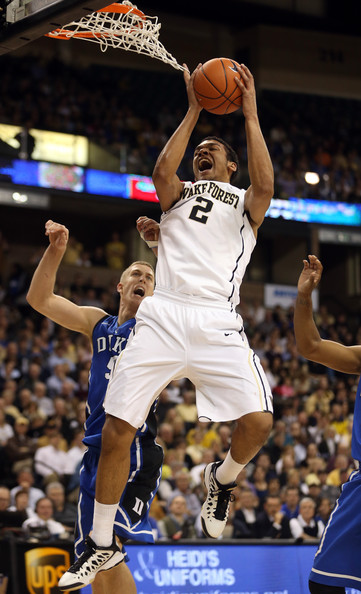
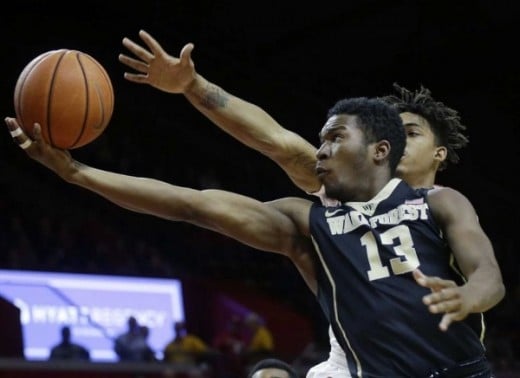
Wake Forest Demon Deacons
2014-2015: 13-19, 5-13 in the ACC
Preseason Projection: 11th in the ACC; NIT
Final Standing: 14th in the ACC
Departures: Darius Leonard (5.7 ppg.) graduated.
Oh what a difference a year makes for Danny Manning and company at Wake Forest. After stepping in to a horrible situation a season ago, Manning was somehow able to make lemonade by treading water within the conference (they could have done much worse than 5 wins) and somehow landed the program's best recruiting class since 2010 (aka Dino Gaudio's last recruiting class).
Lead by two seniors that suddenly have a much more talented supporting cast, this a team that could very well end up playing postseason basketball.
Codi Miller-McIntyre (14.5 ppg., 4.8 rpg., 4.3 apg.) took another step forward as a junior, and things will get much easier with a second ballhandler in the mix. He still can't shoot from the perimeter, but he will be one of the stronger guards in the conference attacking the basket. He'll be joined in the backcourt by Mitchell Wilbekin (7.2 ppg., 38.6% 3pt.), who showed some of his brother Scott's perimeter shooting touch as a freshman and should improve significantly if he has been able to add weight to what was a 6-1, 165 pound frame. The big addition here is freshman point guard Bryant Crawford, a top 80 recruit that should immediately help the team become more efficient offensively. Like Miller-McIntyre, he's a strong and athletic drive and dish point guard that may be a slightly better perimeter shooter than his counterpart. Small forward should belong to a second sophomore poised for a breakout year; Cornelius Hudson (7.5 ppg.) seemingly came out of nowhere to claim the position a season ago. He was confident yet erratic at times, but that should improve with a year under his belt and an improved roster.
6-9 Devin Thomas (12.0 ppg., 8.8 rpg.) will be one of the premiere post players in the conference as a senior. He has been bullying people in the paint for three years, and it seems almost unfair that he should now be older and more experienced than everyone as well. He has the perfect complement in 6-10 sophomore Konstantinos Mitoglou (9.7 ppg., 4.6 rpg., 38.5% 3pt.), who proved to be a dangerous stretch four as a freshman. He is especially important to an offense with two point guards that aren't particularly good shooters. Manning also landed a highly regarded 7 footer in top 70 recruit Doral Moore, who bulked up to 250 pounds over the summer; he should help the team immediately as a shot blocker, and he has good hands and a solid midrange jump shot at the offensive end. 6-10 power forward John Collins gives the team a third 4 star recruit; he's strong and agressive in the post, and should eventually help replace Thomas.
The Deacons finished 280th in the country in field goal percentage defense a season ago; with Wilbekin and Mitoglou hopefully adding strength, and Moore and Collins adding quality depth and toughness in the post, that number should improve. The team also struggled with offensive efficiency, finishing 243rd in the country in overall field goal percentage; that should be aided by the addition of Crawford. Danny Manning suffered through a rough year with a limited roster a season ago, but he is quickly righting the ship at Wake Forest. Deacon fans have waited several seemingly unnecessary years to have something to get excited about, and, while this team may still have to wait a year or two for a return to the NCAA Tournament, Manning has at least given them that. It's almost as though a horrible coaching change made five years ago has long since been forgotten (it absolutely has not).
December 11 Update: Konstantinos Mitoglou has indeed improved his rebounding (although he was embarrassingly shut out out against Arkansas), and John Collins has been phenomenal, averaging 9.8 points, 5.9 boards, and 1.4 blocks in just 14.8 minutes per game. With Devin Thomas a first team All-ACC candidate, the Deacons are as good as anyone in the post. Bryant Crawford has struggled with his shot since missing the UCLA game with an illness, but overall he has played well in the absence of injured starter Codi Miller-McIntyre. When he returns, this is suddenly a very deep and talented team. Wake Forest will have a very real chance to challenge for an NCAA Tournament berth this season.
February 2 Update: Things have fallen apart for the Deacons in conference play to the point that even an NIT berth is out of reach. The team’s problems started with the return of Codi Miller-McIntyre; Danny Manning moved to a three guard lineup against Louisville in what at the time seemed like an attempt to become more efficient offensively (something that should have happened through integrating a second point guard into the rotation anyway) and protect the ball against Louisville’s press, but he has stuck with that starting lineup since. Miller-McIntyre and Bryant Crawford haven’t played particularly well together, perhaps because they both need the ball in their hands to be effective, and the move has had a similar effect on Mitchell Wilbekin, who is getting fewer shot attempts. Playing without a wing player has hurt the team at the defensive end as well. As Manning has searched for a rotation that works, playing time has been inconsistent; John Collins, whose per minute productivity of the bench has been so impressive all year, saw his minutes drop into single digits for a couple of games while Manning experimented. It will be back to the drawing board for the Deacons next year, but the talent level is improving, so there is still reason for optimism.
February 19 Update: The dismissal of Cornelius Hudson from the team after already having been suspended on two occasions in the past is a huge blow to the Deacons for next season. Hudson was a huge favorite to start at small forward and have a breakout junior campaign; his departure presents a very real possibility that the team's struggles may continue next season as well.
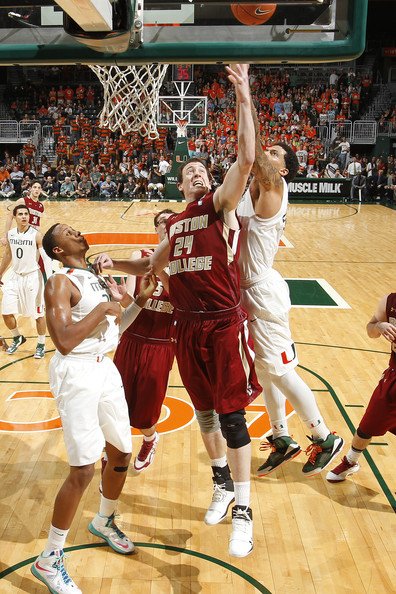
Boston College Eagles
2014-2015: 13-19, 4-14 in the ACC
Preseason Projection: 15th in the ACC
Final Standing: 15th in the ACC
Departures: Olivier Hanlan (19.5 ppg., 4.2 rpg., 4.2 apg., 35.3% 3pt.) was select in the 2nd Round of the NBA Draft; Aaron Brown (14.8 rpg.), Patrick Heckmann (8.4 ppg., 4.4 rpg.), and Dimitri Batten (7.3 ppg., 37.7% 3pt.) graduated; Lonnie Jackson transferred to Boise St..
It's easy to see why Florida graduate transfer Eli Carter (8.0 ppg. at Florida) chose BC in spite of offers from several other major programs. After Hanlan's departure, the Eagle's entire lineup is a giant question mark, and Carter, despite being only moderately talented himself, can step in and have all the minutes and shots he wants. Even though it's not his natural position, he'll likely even find himself as the team's point guard. Shooting guard may go to 6-5 freshman Jerome Robinson; he's limited athletically, but he does pass and shoot well. The Eagles did land a 4 star prospect in likely starting forward A.J. Turner; he's also a capable passer and shooter. 6-5 Garland Owens, who didn't progress much as a sophomore, could end up at the other forward spot by default.
The most anticipated newcomer for the Eagles may be Idrissa Diallo, a strong and athletic 6-11 redshirt freshman that missed his entire freshman year due to injury. He should help BC with rim protection and on the boards. He'll likely come off the bench behind 7-1 senior Dennis Clifford (6.9 ppg., 5.5 rpg.), who finally stayed healthy last year. While he isn't going to make an all conference team, he will provide a consistent presence in the post as long as he remains healthy. With so few options, Clifford and Diallo may even see time together on the court.
This is unlikely to be an offensive juggernaut; they were merely average a season ago, and have since lost their point guard to the NBA Draft. However, even with two big men that are capable defenders, defense is likely to again be what kills the Eagles (they finished 232nd in field goal percentage defense last season), as all of the perimeter players lack strength and athleticism, and there is no real fit for power forward. BC is firmly in position to be the worst power conference team in the country. As there are no reasons for optimism with future recruiting classes either, it seems unlikely that the Jim Christian era at Boston College will last longer than three years, and it could even end after two. I say it every year, but Al Skinner was making miracles happen at BC by consistently keeping them in tournament contention. In five seasons since Al Skinner's departure, Boston College has finished over .500 overall just 1 time. Under Skinner, the team won at least 19 games in 8 of his last 10 seasons.


